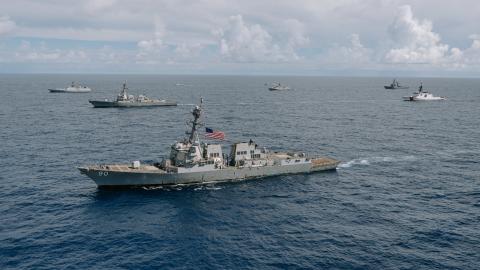
Achieving Adaptable Scale: Fielding Military Capabilities as a Service


United States Representative, First District of Virginia
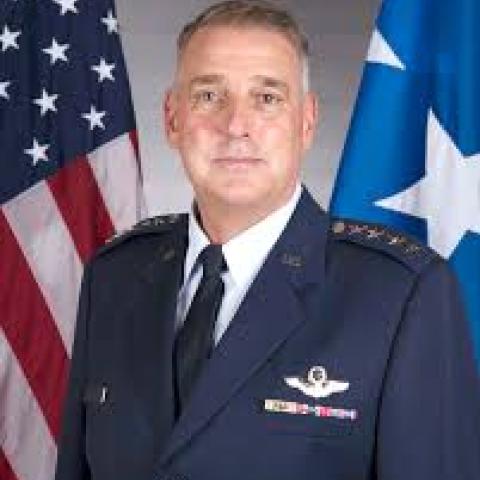
Former Commander, Air Mobility Command, Scott Air Force Base
Cofounder and CEO, Atropos
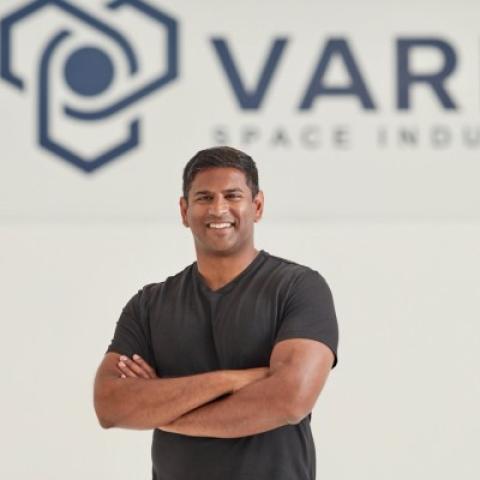
Director, Advanced Capabilities and Strategic Partnerships, Varda Space Industries
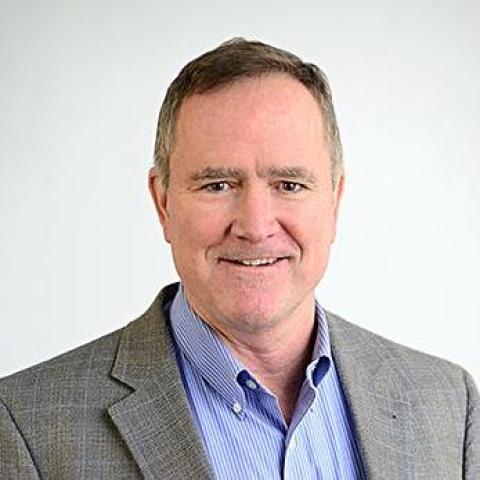
Chairman and CEO, Thayer Mahan

Senior Fellow and Director, Center for Defense Concepts and Technology
Bryan Clark is a senior fellow at Hudson Institute. He is an expert in naval operations, electronic warfare, autonomous systems, military competitions, and wargaming.
Despite more than a decade of reforms to the United States Department of Defense’s acquisition processes, the Pentagon still struggles to field systems that take advantage of new technologies at the pace and scale routinely seen in commercial products and services. Procurement officials have sought to improve results within the current framework. But the DoD budgeting process often hinders their ability to reallocate funding from failing programs to those that address real operational problems.
Fielding capabilities via services contracts is not a comprehensive solution to systemic acquisition practices. But it would circumvent bureaucratic roadblocks and deliver innovative technologies to warfighters more quickly. Buying capabilities as a service can enable the co-evolution of technology and tactics, helping commanders develop adequate solutions to their operational problems and make continued improvements to fielded capabilities.
Join Hudson Senior Fellow Bryan Clark, Representative Rob Wittman (R-VA), General Mike Minihan (US Air Force, Ret.), and experts from the defense industry for a series of discussions examining the challenges and opportunities the Pentagon may face when adopting a services model to meet urgent capability needs.
Event Transcript
This transcription is automatically generated and edited lightly for accuracy. Please excuse any errors.
Bryan Clark:
Great. Well, thank you very much for being here today. Welcome to the Hudson Institute. I’m Bryan Clark. I’m a senior fellow here at Hudson, and I’m also the director of the Center of Defense Concepts and Technology at Hudson Institute. Today we’re going to have a discussion about emerging area of opportunity for the US military and Allied militaries, and that is buying capabilities as a service. Traditionally, the military US and our allies have all bought their own systems, crewed them with military forces, and then operated them themselves. On a limited basis over the last few decades, we’ve started to buy more services, if you will. So intelligence gathering services, space surveillance services, sometimes contractor-operated, contractor-owned uncrewed systems like the Reaper where we operate those overseas. So there’s been some limited cases where the military has pursued services as a way to deliver the capabilities it needs, but those have been very limited cases and really haven’t been applied more broadly.
But capabilities as a service do offer enormous opportunities to the military, and we’ll talk about that today with our guests from the US government as well as industry, talk about the opportunities and capabilities as a service and effects as a service more broadly. Being applied to areas other than just surveillance or intelligence gathering, but also to missions like anti-submarine warfare or surface warfare or electronic warfare and cyber operations. So there’s lots of opportunities here to give us a more agile, adaptable, scalable military by taking advantage of some of the technology advances that’s been made available via the commercial space, as well as what’s been funded by the military themselves over the last few decades.
So to start with, I wanted to have this discussion with General Mike Minihan, who is joining us remotely, as you can see on the screen. General Minihan recently retired as the commander of Air Mobility Command in the US Air Force, which is in charge of all the refueling logistics and air mobility support forces to the US military as a component command to US transportation command. Before that though, he has a head of storied career as a C130 pilot and was most recently before his time at Air Mobility Command, the deputy commander of Indo-Pacific Command as well as the chief of staff in Indo-Pacific Command. So a lot of experience at the pointy end of the spear, as we say, supporting and conducting US military operations. So General Minihan, thanks for being here.
Mike Minihan:
Hey, thank you, Bryan. Good morning. It’s an absolute honor. So I realize I’m the opening act and I’ve got about 20 minutes to get to the main show, but I wanted to extend my thank you to you, Bryan, certainly Colin, Rep Wittman who I think is going to be with you, certainly the panel, and then the Hudson Institute in general. So thank you for having me.
Bryan Clark:
Thanks, Mike. To start with, I’m going to ask you a very broad question, which is why should the military be pursuing effects or capabilities as a service? What are the advantages there and maybe where some of the challenges we’re going to have to work through?
Mike Minihan:
Yeah, certainly. Before I get into the answer there, is important context. You hit my previous job as the head of Air Mobility Command. We’re essentially the team that projects America’s power and America’s Hope. So you saw us in action doing the evacuation of Kabul. You saw us running the guns to Ukraine, the support to Israel, withdrawal from Niger, all those type of things. That’s the combat conflict crisis type things. We also do a lot of humanitarian operations worldwide. So if America wants to project power, if America wants to project hope, it’s going to be on the backs and shoulders of Air Mobility Command, which operates all the big lift, all the aerial refueling, all of the air medical evacuation, and certainly the things on the ground that make those successful.
So I wish that this conversation was happening at the depth that it’s happening now. I wish that that had happened during my tenure. And the way I broadly say this, to directly answer your question, Bryan, the now is so expensive that the services can’t afford the future, and the corollary to that is the now is also increasingly irrelevant when it comes to the effects that we can do. So this approach makes the now affordable and then creates a bright future that both involves a traditional way of developing effects, but also what I consider this to be this more righteous way to develop effects. So I think effects as the service is exactly the right way to go, and I’m eagerly looking forward to the panel later and also answering more questions. Go ahead.
Bryan Clark:
In terms of buying effects as a service, you mentioned being able to address the now more effectively, and I think one of the things that we can certainly do via services is become more agile. So how do you see agility being implemented via a service model for capabilities?
Mike Minihan:
I modified a quote from Paparo. Paparo said, “As ready as we are, I’ll never admit to being ready enough.” That’s about 90% correct, and my addendum to that is I will never admit to being ready enough, integrated enough or agile enough and those three things have to come together. So I think the agility comes from three or four different lines of effort here. The first is we have got, and especially in the service that I came from the Air Force, we have got to get away from platforms and stovepipes, and we have 100% have to get after the effects, the systems and the integration that make us successful against the highest possible adversary. So we’ve, especially in the Air Force. I feel like we’ve gone back to the reason that we mutinied need from the United States Army in 1947. The Mustang approach, the effects based approach, the do it different, the do it better, the do it smarter has got to be the primary means from which we arm war fighters with the tools they need to be successful in any scenario.
So that’s my number one point here is effects has got to bring in a joint aspect that traditionally doesn’t get served by the current acquisition process. So we tend to do platforms, we tend to do stovepipes, we tend to take care of service equities before we administer what the joint force needs to be successful. We have to be as soldiers, sailors, airmen, Marines, guardians and coast Guardsmen. We have to be successful as a team and we rely exquisitely on each other to get that done. The second thing I’ll say here, Bryan, is the all domain aspect. I think this above all things will finally fuse all of the domains, and in doing so, we blur the line between kinetic and non-kinetic and we start talking about lethality and everything that contributes to be lethal. Incredibly important that this effects as a service gets after that.
And then the last thing it should do is it should strengthen the enablers and the equilibrium of the force. So my team that I came off of is an exceptional team, but we’re just the offensive line. We’re not the touchdown scores, we’re not the receivers, we’re not the running backs, we’re not the franchise quarterback. But you certainly know when you have a good O-line, and you certainly know when you have a bad O-line, America has a great O-line in its mobility force, but in order for it to do the things it needs to do it against a near peer adversary. China in the Pacific, we have woefully created a force that is not only the most relied upon force in the history of warfare, but it’s also the most vulnerable, the least connected, and the least integrated. So this ability to strengthen enablers, this ability to understand the system as a whole on what it takes to be that lethal force forward in a highly contested environment and all the things behind it that make it successful, that’s what I’m really cheering for when it comes to effects as a service.
Bryan Clark:
So Mike, that’s a couple of really good points that I want to pull on more is one is this idea of integration. I think one complaint that we’ve received from combat commanders like Admiral Paparo has been we deliver things as service specific components, and then they have to figure out how to integrate them downrange. So he has to then determine how do I make this kill chain happen between Army, Navy, Air Force Space Force capabilities and that doesn’t come together generally, and he has to rely on some special effort on the part, the DepSecDev office to suddenly create a kill chain.
But delivering these as a service relied to do it as an integrated package. So one question out of the discussion you just had is should we think of services as providing these effects that we’re going to generate against the enemy or as the support services that support them? Or are we looking at services that basically do the whole from tail to tooth part of the force? Are we looking for basically a full up service that does everything from the logistics through the effect, or are we looking for mostly effects to be the thing we deliver?
Mike Minihan:
Yeah, great question. First of all, when it comes to people like Admiral Paparo, let’s be clear, Admiral Paparo is the commander charged to win against China. Okay. And so as the premier commander in the fight against China, he is screaming for integration that doesn’t exist, and he’s largely ignored. Let’s be clear, he’s largely ignored. And so not only do we create systems and platforms that don’t talk to each other as a joint team, we often fail to do that within the service itself. The example in my fleet is I’ve got more connectivity on this phone and in my car than I have in the gray tails that are in the Air Mobility Command. So this integration that he’s screaming for I think is perhaps of the highest concern. The other thing I think this whole effort does is it makes the war fighter voice the loudest in the room, which should always be the case.
The war fighter’s voice has to be the loudest in the room. And when you’re talking about someone with the credentials of Paparo, the responsibilities of Paparo, the authorities of Paparo and the frustrations that he’s articulated, well, I think in testimony and in other venues, we need to take those extremely, extremely serious. So to answer your question directly though, it needs to be all of it because eventually, somebody’s got to do that work or somebody’s going to pay the price, and the people that are going to pay the price are the operators and the services, and they’re going to pay it with America’s blood and treasure. So that integration is going to happen. It’s either going to happen at the combatant command level and below, or it’s going to happen on a battlefield, and it’s going to have some costs that are going to be unsavory and completely unnecessary.
So I don’t look at it as only a kill chain. You mentioned kill chain. It’s much broader than kill chain. I realize the lethality piece matters most in the equation here, but you’ve got to back up the kill chain, and I called it the maneuver chain. You have to say, I’m going to reverse engineer what it takes to put this lethality at this time in space, this location on America’s behalf, and I’m going to reverse engineer it and describe the 10,000 other things that need to happen in order to make that successful. One of the things I’m frustrated with most now is I’m all for more F-35, B-21, NGAD, CCA, all the things, but I’m extremely concerned that we’re not building the support mechanism to make those successful. And if you don’t do that, then you’re going to have a lethal force that is handicapped by the lowest common denominator, and that handicap is going to be fatal and unsuccessful in a modern day scenario either in Europe or in the Pacific 100%. So I think I answered your question there, Bryan.
Bryan Clark:
Yeah, yeah, yeah. That’s what I was getting at is this idea that we want to make sure the services are covering the entire scope of developing the capability, fielding the capability, delivering into the field. So it’s a logistics concern. It’s a C3 concern. It’s also a weapon or effects concern. So you’ve got to make sure you address all that or else you’re only giving the department a piece of what it needs and somebody else will still have to figure out, how did I transport it there? How do I support it while it’s in theater and how do I sustain it while the fight goes on?
Mike Minihan:
And just one more point here is we’ve been lulled into a false sense of security. I’ll use the Iran strike, phenomenal execution by the joint team, all services pointing in to the O-line, the whole nine yards. Everybody that executed needs to be applauded for courage, professionalism, all the nine yards, and it’s a junior varsity foe in a permissive environment. Okay. And under any circumstance against a China for example, we will be contested from the mainland forward in all domains.
We will be spoofed, jammed, the lights will go out, the satellites will go out, all the nine yards, all the things. And so we have got to make sure that we are solving for the hardest problem set here and can’t rest back. So to a certain extent we’ve been able, due to the uncontested lines of communication and to foes that can’t give us enormous challenges across all the domains, across all of the battle space at great distances to think that we’re good to go, it simply won’t be the case in a China scenario. So this is another thing this has the ability to get after I think effectively and certainly more rapidly than it’s being done.
Bryan Clark:
Yeah, and that brings up another point that I was going to raise with you is the Iran strike was obviously a success and very impressive, but it took the entire force that we have of B-21s essentially to pull that off and a substantial amount of the enablers. So when you think about the scale at which we might have to do operations against a country like China or an adversary like China, that’s another area where I think capabilities as a service might be able to additional leverage because it allows us to maybe scale in a way that we wouldn’t be able to do if the military is its own industrial base, its own industrial provider.
Mike Minihan:
Scalability matters here. Just in my time when I was in Air Mobility Command, I was trying very provocatively to start thinking about this, but one of the things I wanted to do was give the KC-10s that were retiring out of the Air Force to American air refueling industry so that these KC-10s just don’t go to the boneyard and rot away in the desert. And that we preserve that capability to come back as a service so we can use it for the war fighter needs that aren’t being met. We can use it for the training that never gets serviced. We can use it for perhaps homeland defense and normal operational flows. And then in times of crisis and combat, we can have those fill in things and then put the great tales forward. So that’s one example. The same thing could happen for C-5s. Why do we spend billions of dollars on C-5s and have a less than a coin toss chance, a less than a coin toss chance, 46% chance of that airplane getting off?
As much as I love that airplane and as much as I adore the airmen that fly fix and support it, it is a disservice to this country to coddle that type of ill effects and sustain it for longer and longer. And so in my world, you give C-5s to American industry and they do what American industry does best and they make it successful. And then the last point is probably the connectivity piece. I talked about my phone and my car having more connectivity, but connectivity as a service out of great companies like Gogo and others could absolutely 100% get the connectivity instantly needed into the great tale of cockpits of Air Mobility Command, and then we could just scale it up and down as required, as needed just like you do your cable TV or when the NFL package comes up on for the season, we simply do that, but we have got to take advantage of the discussion that you’re having and make these things come real.
Bryan Clark:
So Mike, stepping back now to talk a little more philosophically, but what the discussion suggests is the DOD needs to rethink its role in delivering defense capabilities from being the industrial provider, that it builds all of its own stuff to instead think of itself as a customer or a consumer of capabilities, some of which may come from the defense industry at their behest, but some of which might come from commercial providers that are doing it more or less on their own and the DOD buys those services. But it’s really a much different mindset from the mindset of I build everything myself. I’m an industrial enterprise and a operational enterprise to being much more of an operational enterprise that has a variety of different sources. Is that of the transition we’re envisioning here?
Mike Minihan:
I think it’s great. It is a great analogy, and I’ll say this, we got to get to a place where it’s like my iPhone here where you put a service in place and that service has upgrades that happen automatically. And then when the upgrades can’t make this old iPhone successful anymore, then a new one in an affordable fashion jumps in and picks it up and gives you a lifespan that’s way more effective than a program or record. So let’s be clear here. There is accountability that will come with this that doesn’t exist right now. The accountability matters. The services could be held accountable and it gives flexibility and accountability down to a lower level. I don’t want to make this a therapy session for me, but there are primes out there that delivered substandard in terms of time costs and specifications, and they’re rewarded with more money, increased program of record, and that does a disservice to this war fighter.
It does a disservice to the joint team and it does a disservice to the country that’s trying to project power and hope, but as a service, you can hold it accountable. And I don’t mean that in a Tony Soprano way. I mean that in a way that both the wonderful innovative American industry can deliver services, develop them, and then acknowledge when they’re no longer effective and then move on to the next thing. So I think this accountability piece, I can hold a service more accountable. I can hold an effect more accountable, more than I can do that with a program or record. I mean, there are multiple program or records I would’ve walked away from. I just don’t know how some of these program or records survive. I just would not have my fingerprint on it because there’s no justifying it in terms of America’s treasure that we’re spending on it. And there’s no justifying it to the old effects that’ll happen on the battlefield when not if, when it’s unsuccessful.
Bryan Clark:
Yeah and obviously part of the problem there is that if you’re the industrial enterprise building it, then you feel like you own it and you have to just stick with it until you can make it work. Whereas if it’s a service, there’s a lot less invested in it emotionally as well as monetarily. So it’s a lot easier to walk away from it. And from the industry side, I imagine the service provider, it’s easier for them to transition to a different service. They don’t necessarily have to get rid of all their invested capital because they can transition all that into some other product or other service line. So it seems like the lower regret on both sides allows you to be more agile.
Mike Minihan:
Yeah, and I realize this is about a relationship, it’s very rarely one side of the relationship is right, and the other side is completely wrong. The relationship drives the behavior good or bad. And so the relationship matters here. What I grew to appreciate during my time at AMC and now that I’m on the other side of the coin here is that the American innovative companies’ industry, their patriotism is displayed in their patients with a system that is ineffective, bureaucratic and just unable to do what it needs to do.
Everybody can agree to that, but yet they keep coming back for more. God bless them. American industry keeps coming back for more because they see the higher calling and they have the traditional patriotism to that we know that these tools are needed by the war fighter. So really at the end of the day, this is about can we get the proper tools in the war fighter’s hands at speed, at cost and at specs so that they have something that’s relevant. By the time it goes through the bureaucracy, by the time it goes through the normal method, it’s either too late inadequate or just simply doesn’t work. And forgive me, I just think this country deserves better than that.
Bryan Clark:
Well said. I appreciate it. That’s great note to end on. So thank you very much General Mike Minihan for being here and giving us those words of wisdom to talk about effects as a service. We’re looking forward to getting to those in more detail during the panel. So thank you very much for being here and-
Mike Minihan:
Thanks Bryan.
Bryan Clark:
... We’ll talk to you later and we’re going to transition now to our panel. So if you all want to come up here, I will meet you right there. All right, excellent. Okay, well to talk a little bit about that relationship that General Minihan just discussed between industry and the government. Let’s talk about the industry side of it now and three innovative companies that are looking at different takes on how do we provide capabilities as a service to the military. This is something I think there’s been long-standing examples of it, but I think these three companies represent new takes on which direction we can go in.
So first of all, Mike Connor is here from ThayerMahan who they work on anti-submarine warfare capabilities and he can talk more about that. Mike was the former commander of US Submarine forces. He was also my former boss and one guys during our time in the Pentagon. I really appreciate you being here, Mike. Next to him is Colin Carroll, who is the CEO and co-founder of Atropos, which is a company doing capabilities as a service focused on uncrewed air systems initially, but looking at other capabilities as well. And you could talk more about that. And Muk Pandian is here from Varda Space Industries where he is the, just make sure I get it right, Director of Advanced Capabilities and Strategic Partnerships and Varda does on-orbit and de-orbiting space capabilities and he can talk more about what that consists of. And so it’s a very interesting intersection of commercial and military space. So gentlemen, thank you very much for being here.
Mike Connor:
Thank you.
Bryan Clark:
And so to start with, I wanted to pose a relatively broad question, just like I did with General Minihan to you is to say, why should we be looking at capabilities as a service and where do you see the opportunities for DOD going beyond the traditional stuff we’ve done, which is space-based surveillance or that kind of thing, which is a long-standing approach. So I was talking with you, Mike.
Mike Connor:
Yeah, I’d like to thank General Minihan for getting us all pumped up because the bottom line, is the country does deserve better than they’re getting. So in our case, we have one foot in the commercial sector at sea and the other into the DOD sector. And we do what we do with a combination of manned, unmanned and remote systems. And everything we do in the commercial sector is as a service. That why do we do that? Because the customers demand that we started off trying to sell them hardware. We don’t want your hardware, we want you to get stuff done for us. We want to pay you when you’re doing it. We only want to pay you when it’s working and when the job is over, we want to stop paying you. And so there’s all kinds of room to do the same.
We do a little bit of that in the government side, but most of what the government side is GOCO government-owned, contractor operated. There’s definitely room to go further for all the same reasons, it’s more agile. And I’ve had some talks with senior government officials in the last two weeks talking about maritime and shipping and how much of that we can do as a service. And the answer is, a lot. At some point you need to have a military person with all the rights and authorities they have to engage to apply lethal force, but all of supporting activities right up until applying that force can and in many cases should be done as a service. So we have a more agile capability and a much better value for the country.
Bryan Clark:
So thanks Mike. And so Colin, you guys are brand new to this area. You’re not new to defense, obviously you’ve served in the chief data and AI office, I guess in its previous guise as the joint AI center and then also working in the front office over at the DepSecDef. So you’re no stranger to defense and obviously you’ve been in the Marines as well, but where do you think the opportunity is going forward and what are some of the areas that you guys at Atropos are trying to pursue?
Colin Carroll:
Yeah, so my experience in the DOD is buying weapons systems and then operating weapons systems. So I’ve done that in the department. I’ve also been out in industry selling weapons systems to the department. My last short-lived stint in the department was at the deputy secretary’s office. And I can tell you after 88 days, it is an unfixable problem DOD acquisition. It doesn’t matter how much reform is happening now, the reforms that we’re seeing now are not going to have fielded weapons systems in a war fighter’s hands, a squadron of planes in the Air Force, for example, until mid-next decade, which is probably well after the time that we need them. And the time there’s a conflict.
I think Atropos’s approach here is we’re going to build autonomous systems, so design build, and then we’re going to operate them as a service. I don’t see the department’s ability to acquire them, develop them, test them, Congress’s ability to appropriate dollars in a manner that makes sense on time. And honestly, by the time that a PEO gets through that process and you get the DOTMLPF back end of creating a squadron of Air Force pilots training them, the MILCON associated with doing the airfield, I think that the requirement for the airplane at that point’s like a decade out of date. And so I think the industry can actually just move much faster. Like Minihan said with his iPhone, Hey, it looks like this one day, six months later, a year later, it looks like something different. That’s because the war fighter Admiral Paparo says, “This is what I need now.”
Bryan Clark:
And one thing Colin will want to pull the string on is the role of software and new technologies enabling that level of agility. And that may be one of the changes that’s happened here. So, Muk from the Varda perspective, what led you you guys to think about being able to move into these space capabilities as a service, which I think is something that I think most people would not think is possible. And I think the kind of thing you’d do as a service seems like the kind of thing that would be done by the government, or maybe you could get SpaceX to take you to orbit, but doing anything on orbit seems like it’s something you’re going to have to do yourself. So could you talk a little bit about that?
Muk Pandian:
Yeah, we’ve had to think of it from the start. So Varda does pharmaceutical crystallization in orbit. When we go talk to the pharmaceutical industry and the material science industry, we don’t talk to them about space. We talk to them about what reformalizations we can give. They don’t care about that half of our business is having to build spacecraft, put them on orbit and bring it back down. They just care that they get that effect at the end. And that’s what we’re talking about here. So we had to go develop these spacecraft as a service to our own internal pharmaceutical crystallization team. The big piece of that is that we have these small one-meter and diameter reentry vehicles that bring those products from space back down. And when you’re in low earth orbit, you’re traveling at 18,000 miles per hour.
So when you hit the atmosphere going back down, you’re coming in at Mach 30, who else cares about that DOD. There’s a lot of vehicle systems and everything that really care about that, and it’s a very expensive value proposition to go create those vehicles. There’s just not a lot that traverses through there, and there’s a lot of unknowns there. So we started on the DOD side as offering that service that we offer back to our pharmaceutical team over to the DOD. We have a great partnership with the Air Force right now where we’re flying regularly and we’re able to support their mission sets. I think there’s a lot we can do more with that same model. Again, that’s fixed price service at Mach 30. It’s not something that you could have thought about five years ago, and I think-
Muk Pandian:
It’s not something that you could have thought about five years ago. And I think if the DoD were to have created something like that, you’re talking about a $500 million R&D program and expensive capability that you have to keep in service for a long period of time, whereas now we’re just able to go do that at a fixed price as a service.
Bryan Clark:
Right. Right. Right. And there’s lots of potential use cases for that that we can sort of address as we go.
So what’s made this possible? What has made this transition to services for the DoD that address more than just the standard surveillance missions? Kind of what’s enabled that to happen from a technological standpoint and what’s driving it from the threat perspective? What’s your view on that, Mike?
Mike Connor:
In our case, it’s low-power electronics that can do far more than they could do 10 or 20 years ago. That allows you to deploy very capable remote systems. It’s a whole menu of satellite communications that get better and cheaper every six months. And it’s the ability to leverage cloud computing to run your backend and distribute the information very quickly to a number of users.
We’re so used to the world that we worked in where the information had to follow the chain of command with appropriate delays at each point, and now you can put the information out to a bunch of people, they can have real-time discussions even though they’ve broadly distributed. They can make decisions looking at the same set of facts, and that allows them to act quickly. So the technology is far different than it was, and what we need to do is change our thinking to adapt at the speed at which the technology is evolving.
Bryan Clark:
So Colin, what do you think is, I mean, obviously technology of microelectronics have changed, software is now much more powerful in terms of how it defines capabilities, but I think the threat is also driving some of this or the environment is driving some of this. So at Atropos, where do you guys fit there? What are you trying to leverage?
Colin Carroll:
Yeah, if you start with the assumption that, like many said, in a contested environment it’s going to be very difficult for things with humans in it to go in that environment and survive. And then if you take that back one step further, it’s United States is probably not super happy with losing thousands of sailors or airmen. And so that leads you to unmanned and autonomous systems.
The way I look at this is I’m an aerospace engineer from the Naval Academy, did not fly in the Navy, but got lots of friends that fly in the Navy, most of my company are former pilots. They go through years of training their brain in order to operate an airplane. An autonomous system goes through a similar set of training except you’re training a piece of software and a piece of hardware, it’s not a human.
The difference between those two things is that the former we’ve been doing now forever and we understand how to train pilots. Engineers develop and train autonomous software, and in my opinion, in the next decade that’s a pretty fragile technology and engineers are going to be fighting that. It’s not going to be E5s and O3s and the green or blue suit-wearing people. It’s just too fragile a technology.
So if you have that general assumption, I’ve seen this both at Anduril, I’ve seen it from the DoD perspective, it’s pretty fragile TRL stuff. Engineers are going to fight it. So the way that we approach our hardware, and we are building hardware, we’re clean sheet vertically integrating hardware and software, we look at the airplane as a customer of the software team itself.
And so the software can iterate. We’re going to settle on a design for our first product aircraft and it’s going to be that way. It’ll be modular, you can make changes to it, but the software is where you’re going to be able to update it continuously from what we call a basic design reference mission to kind of like an onion going out, more and more complex things.
Autonomous vehicle industries invested tens of billions of dollars in making that concept a real thing. If we were starting from scratch seven years ago on this, I think it would probably be a DARPA program.
Bryan Clark:
Right. Right. So just to follow up, so to what degree do you have to work on the design of the aircraft to make sure that it’s able to support autonomous operations so it doesn’t need to get repaired or maintained or fussed with?
Colin Carroll:
When we first kicked this off a month ago, we were going around, and there’s a lot of questions on why not just take a C-130 or C-17 and make it autonomous. There are companies that are out there trying to do that, the DoD’s paying some companies to try and do that.
Those airframes are 70 years old, they’re not digital. There’s more money going into retrofitting that airplane than, honestly, it would take us to just clean sheet design a plane.
Bryan Clark:
Right.
Colin Carroll:
So the way I look at it is the plane is being built around a brain, a software brain, and therefore it doesn’t need all the doohickeys that a plane that’s got a human flying it or is being teleoperated by a human from 5,000 miles away like an MQ-9, doesn’t need to be designed that way.
Bryan Clark:
Right. Yeah, and we can dig more into that too, because I think there’s opportunities for a service provider to do that kind of rethinking of the design of the product in a way that DoD couldn’t. If DoD is the industrial enterprise that has to create it, well, we can’t keep turning out different versions of it or else we end up creating a sustainment problem for ourselves.
Colin Carroll:
Many brought up a point, the POs, and it’s interesting to me the requirements guys like AMC, they always hate the POs. Paparo, he hates the POs. Everybody hates on the POs thing. POs are doing what they’re trained in charter to do, and they’re in a system that’s terrible, most of them recognize that and it’s very hard for them to get out of it.
I think that the great thing about a services play is you can just move much, much faster. You don’t have to worry about government PM, you don’t have to worry about government developmental tests, operational tests. In an unmanned system, there’s never a government pilot in the seat and you don’t have to worry about congressional appropriation. So the ability to move really quickly, the biggest thing though is the requirement.
So I came from Anduril. Anduril is one of the performers on Collaborative Combat Aircraft, CCA, Inc 1. That requirement is probably eight years old at this point. The AOA was done a long time ago. It requires airplanes to be on aprons within the first island chain, which is a huge risk.
Bryan Clark:
Yeah.
Colin Carroll:
It also requires a lot of footprint on the ground, another huge risk, a lot of gas on the ground, another huge risk. But Anduril’s stuck in this, “We’re building that thing as the government wants.” The government’s already decided like, “Hey, we’re not really sure we want that anymore. We’re going to move on to something else.” But they’re committed now in that program. It’s a huge debt to have.
Bryan Clark:
Yeah. That’s a great point to think about that, and we can talk about that more as we go.
So Muk, in terms of your business at Varda, obviously the lowering price of space launch has contributed to the ability to turn to services that are based on things that get dropped out of a Starship or something. So can we envision a world in which commercial space launch is being used to deploy a lot of military capabilities beyond just satellites? Is that something that we might start trying to think of?
Muk Pandian:
Yeah, I think building off what Colin and you were just talking about, rethinking things once the capability is there, right? The space industry has had to rethink how they do things because launch is becoming commonplace and it’s very low cost to get to orbit.
It’s about $2 million to get 400 kilograms to orbit with SpaceX, and you can literally buy it on their website. That makes you rethink how you do everything. You don’t need to spend $1 billion on a satellite because it has to be up there and it’s going to cost you hundreds of millions of dollars to go launch.
So that rethinking piece of once costs come down, once things become commonplace, what can you go do with that is I think what’s happening in the space industry right now. And we’re taking that from the reentry perspective. Reentry is not commonplace. There’s only us and SpaceX that are doing it regularly common right now, and SpaceX has a very specific mission for people in planes or people to be able to go get transported to and from space with their reentry systems.
What happens when you have autonomous systems that can regularly reenter and come back down? When you look at the military perspective and utility there, what happens, what paradigm can you open up when you have reusable, recoverable satellites? You can look, think about doing sorties to and from space. It’s just a fuel cost just like your FAT at that point.
You can go launch a Starship that shouldn’t one day be fully recoverable and reusable. You can go then pop out a vehicle that then is also recoverable and reusable and you can do really interesting things with that.
We right now put everything in constellations that are 500 kilometers and more because you don’t see a lot of air there, but there’s a lot of interest in a very low Earth orbit like going around 200 kilometers. But you don’t want to dump satellites there because they’re only going to last days or weeks and they’re capital expenditures so you’re just throwing away these expensive assets.
But now if you can think about a fully reusable architecture, I think that’s really enables this new way of thinking for the war fighter, what you can go do, and it’s coming commercially, so.
Bryan Clark:
Yeah, really good point. And so to kind of extrapolate on that, Mike, the US Navy, US military has a lot of anti-submarine warfare sensing capability out there. So where does that capability like ThayerMahan’s fit into that? Or is this something that’s mostly going to be a focus for our allies who don’t necessarily have the same architecture that the US has?
Mike Connor:
No, I think it’s for both. We have a lot. We don’t have enough. And a lot of what we have is tied up in lengthy overhauls that have gone way beyond their design frame. And we also don’t have the flexibility to put new things in new places, and the world is changing faster than the architecture of some of those systems.
So we need to have flexible systems that can go where we didn’t know we were going to have a fight last week, last year. And then by doing that, the types of systems that you do that with are inherently cheaper. They are more compatible with the financial capabilities of allies, and it allows us to partnership in the undersea in ways that we couldn’t conceive of before because we had this exquisite platform and they had something that was far less and it was just hard to work together.
Bryan Clark:
So which brings up a really good point. I think in his hearing this morning, Admiral Caudle mentioned that he might be willing to pull the plug on USS Boise, which was a 688 that I think has done one deployment, or I guess probably a couple of deployments in its time in service.
But we’re having to do that because it’s so difficult to get it through a maintenance availability because the lack of capacity at the shipyards to do that. And that comes from the military being the industrial enterprise as well as being the operator of those systems.
So do models like we’re talking about here with service models, is this a way to try to reduce the pressure on that industrial enterprise that we might... We’ll still have to keep some of that because there’s certainly some systems that don’t lend themselves to a service, but.
Mike Connor:
I can say with a fair amount of confidence that we could cover the Western Pacific with ubiquitous acoustic sensing for undersea domain awareness for what we’ve spent in the last decade on that one overhaul.
Bryan Clark:
Right. Yeah.
Mike Connor:
It’s just we have to make decisions like that. And if he makes that hard decision, good for him, because someone needs to make it. And a lot of times we look at the sunk cost of exquisite systems, and industry can never afford to look at sunk costs. They have to at how do I provide a valuable service today and tomorrow so we can stay alive as a company?
Bryan Clark:
Right. So Colin, to go take this example little bit further, the US is getting a bunch of new platforms through the Reconciliation bill, the One Big Beautiful Bill Act. Do we need to think about that investment being used to buy new systems? But then at the same time, should we retire a bunch of older platforms instead of trying to maintain them and instead look at service models to fill in the capacity that they would’ve otherwise provided?
Colin Carroll:
It’s a trade-off, I think, between things that you have now and things that you can buy relatively quickly and they’ll be made, relatively being years for some of these platforms, but relatively quickly versus, “Hey, I’ve got the ability to do ubiquitous, smaller, low cost of tradable, expendable type stuff,” and where do those live on their lifecycle of maturity as a product?
So a really good example, there’s been a program in the DoD, it’s a underwater program called Orca XLUUV, it’s a large submarine unmanned, it’s been going now for seven or eight years. Boeing’s been the prime contractor but it’s a couple other people that are trying to get that space.
Admiral Paro says, “Hey, I really want those things and I need 10 of them out here.” Well, there aren’t 10 of them in existence that are product-ready. If there were, someone could operate those as a service and that might actually be a better model for the Navy to go buy those than, “Hey, we’re going to stand up a big XLUUV program, and 10 years from now we’re going to get 10 of these things. And yes, they will be thoroughly developmental tested and operational tested.” And we’ll all know, by that point the world will be over, we won’t even need those anymore, be some other thing that we need.
So I think you take a company like Anduril that’s moving really quickly on XLUUV, it is now in the process. So who knows how that’s going to wind up, right? And it’s expensive to go say, “Hey, we’re going to...” Let’s say it’s $50 million of sub or $30 million of sub. It’s a lot of money to invest on the private side to make a fleet and operate that fleet.
Bryan Clark:
Yeah.
Colin Carroll:
So it’s a risk you got to take. It’s a risk. Calculated risk.
Bryan Clark:
So to talk about that a little bit more, so a lot of the wargaming we’ve done looking at future combat overseas, when you use that XLUUV, you need a lot of them because they’re fairly slow and to get them out there and keep them on station you have to have a rotation of them, so you end up needing dozens of them to be able to cover it. But they do provide some unique ability to deliver payloads into some of these really contested areas.
If we were to instead buy that as a service, you kind of push that decision in terms of, well, how do I deliver those mines, for example, onto the service provider. So they have to figure out, well, what’s the best way to do that? Well, maybe it’s some combination of XLUUVs, maybe it’s something else, but you make them innovate to figure out what’s the right way to do it instead of the DoD having to come up with all those concepts as well as be the industrial provider.
Colin Carroll:
Yeah, I’m in firm agreement with that. I think that the right answer is industry does its own mission engineering and ops analysis in conjunction with the government to gain conviction in the effect that is needed, and then what is the best way to deliver that effect? I don’t think that we’re ever going to get to a contract where it’s we’re literally buying effects, at least not in the next 10 years, but maybe that’s the way to go.
Bryan Clark:
Or, well, I think in some cases... I mean, it could be that you’re buying effects I guess. So but from the perspective of Varda, when you guys work with the Air Force, what does that service contract, I mean not specifically, but in general, what is that service contract asking you to do?
Muk Pandian:
Yeah, it’s really just flying. We have to do some integration to make sure we’re getting the data and the analysis they need, but it is really just coming down to size and weight and power onboard the vehicle. So we work that, we give them standard interfaces, we kind of say if it fits, it ships, and we’re able to go do the mission set.
I did want to echo one piece that you were mentioning. The wargaming I think is absolutely an important part that needs to go down to companies like ours as we’re developing these services and as we’re looking at these new capabilities. I think a lot of this new startupy type companies take a first principles approach for everything, and they need to have that conviction. I think Colin said it best. They need to have that to be able to go build this as a service and invest their own time and resources into that. And I think there’s a better product that gets put out of that too.
So I think that joint requirements, developments, understanding wargaming with new effects that these companies can go bring are an important piece of the puzzle there.
Bryan Clark:
So you mentioned requirements, and I’ll drill down in that in a second. So for Mike and Colin, you guys have worked inside the DoD at different points and understand the challenges of defining a requirement through analysis in advance and then attempting to build something to it that’s going to take a decade to reach fruition. There’s a lot of churn-
Colin Carroll:
Don’t forget we changed the requirement 100 times too.
Bryan Clark:
Right. Then we changed the requirement 100 times. Right. But there’s a lot of churn right now in terms of rethinking that whole approach. So the SPEED Act. And then there’s some efforts going on inside the department right now to look at revising, if not eliminating, large parts of the joint requirements process and say we need to approach this in terms of operational problems and how do we solve those problems, and opening up the aperture in terms of what the solutions might be.
Does this service model really lend itself to a world where we’ve done more like what INDOPACOM and even UCOM have said is, “I’ll give you an operational problem, give me a solution.” Let’s not get into the discussion about predictive requirements analysis. Does the service model, what we need, is that maybe a really good model for how do we develop solutions against a problem?
Mike Connor:
I think the service model is inherently more agile and it leads to people quickly evaluating what they can do in the near term, as opposed to traditional requirements that usually become part of the sales pitch for the program, “We’re going to go this fast, we’re going to go this high,” and so forth.
And I think to deliver a lot of those effects, you don’t need to have some glamorous platform capabilities. What you need to have is payload capabilities, and they need to stay on station for extended periods of time with very little outside support. And you can do that better, faster, cheaper by leveraging commercial technologies that have solid existing supply chains already than you can by building an exquisite supply chain to support an exquisite capability that may not be needed.
Bryan Clark:
Right. So Colin, as we move into hopefully a world without formal requirements in the same sense we’ve had in the past, is this service model the way we need to think about satisfying those operational problems?
Colin Carroll:
Yeah. I’ll say in my limited 88 days in the department, one of the prouder things I was able to accomplish is letting your colleague, Dan, and some of his cohort in to disrupt JSIDs. And I’m super excited to see what’s going to come out of here in the next couple days.
I think what Dan and the team are putting together there on a future requirements-type process with the concept of the jar and freeing up a in-year bucket of money to go after things that maybe we didn’t see coming or that industry kind of popped on us, I think that is really critical, and I do think that there’s a huge services component to that.
Bryan Clark:
Yeah.
Colin Carroll:
What I’ve learned in my month here of raising money and trying to do a startup, which I didn’t do at Anduril or applied in tuition because I wasn’t involved in the raising side, is there does have to be some level of revenue build so I can go to private investment and say, “Hey, I need $500 million. I’m going to build a plane.” Maybe you got to show them that there’s something on the backend.
I think RDT&E that compliments that where you’re basically saying, “I am going to focus on one product, Varda style. We are going to make a thing that reenters and we’re going to make it... We know it works and then we’re going to sell it as a service.” That’s what we’re trying to do as well and not this kind of I do some private investment, I get it to a certain point and I rely on DoD to take it the rest of the way, stick it in a program, meanwhile I focus, go on to the next thing, go on the next thing, go on the next thing. So I do think that there’s value in what Dan and team are putting together there.
Bryan Clark:
Yeah.
Colin Carroll:
Yeah.
Bryan Clark:
Yeah. And if you are on the industry side, you have to have a good sense of what the operational problems are so you can come up with that solution, say, “This solution is going to be applicable to a variety of operational problems the department’s facing. I’m confident that if we build this, we can offer this as a service.” As opposed to, I think the prime perspective is, “I’m not really sure exactly what DoD’s going to ask for because I’m dependent upon the requirements process, so I’m going to just rely mostly on them to provide me R&D and kind of nurse my programs along.” It just seems like a totally different model.
Colin Carroll:
The primes are looking at the labs in DARPA and they’re taking money to mature technologies that are going to be in their 10-year out or seven-year out future weapon system that they aren’t going to spend any money on until the DoD shows up and says, “Milestone A. Here’s RDT&E to go.”
Bryan Clark:
Which works great if the DoD’s fine with not getting something for 20 years, and then the industry can just be funded for 20 years to mature and then eventually develop the capability.
Colin Carroll:
I think that the DoD is going to pilot services for, I mean, the SASC put in anything as a service last year. I think there’ll be some additional language this year on kind of tearing that down.
I do think there’s a question on how do you define effects? What is a lethal effect? Where do you draw the line for law of armed conflict, contractor doing something and a military person doing something? But that’s something I think that we need to explore like where is that line and how do you go from steady state to conflict where a thing might be doing an ISR mission or logistic mission, but now it’s got a lethal payload? Who’s going to operate that? How do you integrate it in with the rest of the joint force and the operation?
Bryan Clark:
That’s a really good point. I was going to ask you, Mike, about that. So if we have a ASW surveillance network, we’re doing ubiquitous undersea sensing in the Indo-Pacific because we decided to give ThayerMahan a bunch of money to go do that, you might be then part of the kill chain. So you’re part of the ASW kill chain. How do you see that working as a commercial service provider to DoD now being integrated into their kill chains?
Mike Connor:
I think there’s nothing wrong with being an information provider to DoD. There’s probably nothing wrong with carrying payloads that are kinetic and non-kinetic into the theater and hosting them in theater.
Obviously the decision to apply kinetic effects and against whom, that’s an inherently government decision and should stay there. But that does not mean you can’t execute that decision with the right government people using an infrastructure that is almost entirely or entirely run as a service.
Bryan Clark:
Yeah.
Colin Carroll:
I am in firm agreement with that. I’m not sure that everyone... I think this administration is probably also very much agreement. They’ll take it another step and say letter of marque, give you a thing and go over there and do stuff. But on the legal side, like OGC in the department, OGC on the Hill, that’s a thing that we’re going to have to work out.
Bryan Clark:
Lawyers. So lawyers might get involved. So yeah, if we do go in that direction where we’re starting to look at payloads being carried by service providers, platforms that might be doing other things, ISR, day-to-day, but then also have this ability to transition to combat, it seems like for non-kinetic effects if we’re talking about electronic warfare, cyber, that should be something where it’s very easy to envision the contractor having the ability to execute that.
Mike Connor:
It should. I’ll add one more caveat though. In the maritime domain, we’re always working against what are we doing in an EEZ and what are we doing in territorial waters, right?
So a government vessel or platform has tremendous rights as long as they are in international waters. A commercially-operated vessel or a controlled vessel may find itself restricted by EEZ. And so that may impact at what point the government takes ownership or at least declares control over that vessel. I think it’s solvable. It will probably require some lawyers.
Bryan Clark:
Right.
Colin Carroll:
Yeah, the concept I’ve been working on with the SASC is a thing called Government-Controlled, Contractor-Owned and Operated. So GC COCO. At some point I think you’ll probably see that in some authorization language, might not be in ‘26, but maybe in ‘27.
And the question is where is that line drawn? That’s why I think the department probably needs to pilot that maybe via wargames. We need to figure out what that is. Where are we willing to accept risk?
Bryan Clark:
So one thing that that raises is for MOOC for example, you guys do predominantly commercial business, but I think you have government payloads and commercial payloads, the same reentry vehicle routinely, right? So if we’re looking at this model where the government may be using one of their payloads as part of a effects chain against an opponent, is that going to be cool with your commercial customers also?
Muk Pandian:
Yeah, I think, well, there’s a couple pieces there. When we’re talking about what is a combatant and what is a combatant doing, that’s where you’d have a different chalk line, right? So everything we’re doing right now has no effect that we’re delivering anything, it’s all for testing or research purposes.
Now, our commercial customers, oftentimes they don’t care about how we’re doing things regarding... They don’t really care about the space piece of this. They just care about the material science piece at the end.
So as a company, we have to consider that, but generally they’re very interested in just us delivering the core capability that we’re delivering at the end.
Bryan Clark:
So they won’t worry that much about that?
Muk Pandian:
We haven’t experienced that yet. Yeah.
Bryan Clark:
Okay. Well, but that could be an area where you get concern of some of your commercial suppliers. Maybe foreign companies in foreign countries are like, “I’m not really all that excited about being on board a reentry vehicle that might be executing a military mission while you’re doing my service.”
Muk Pandian:
Yeah. I think the reality is we’re going to have to decouple some of the things we’re talking about here and have dedicated mission sets that are for some of these other operational things that we can think about in the future, but that’ll depend on kind of where the chalk line is and what we’re trying to go do.
Bryan Clark:
Right.
Muk Pandian:
Yeah.
Bryan Clark:
So I want to let the audience know we’re going to be opening up for audience questions here in a couple minutes, so if you have questions, please kind of formulate those and I’ll ask here in a second.
But before we do, I want to talk a little bit about, General Minihan talked about this idea of putting the war fighter at the center of it and rethinking who the customer is, because if we’re doing these services via operations and support funding or operations and maintenance funding, a lot of folks have that kind of money and the authority to use that kind of money so you might be doing it directly for a combat commander or a component commander or for the service.
Where do you think the customer would be for the kinds of services you’re providing or who is the customer you’re dealing with today?
Mike Connor:
Well, everything that we do is driven by the customer at the pointy end. And the challenge is to get the needs that they start in the far forward and they come back through JUONs and other requirements that get adjudicated through the COCOM and the service and DoD, and somehow that process needs to move a lot more quickly. It probably requires more comfort with interaction between industry and the people in the far forward to do that.
And the special operators got very good at that because they had to. Well, I think Admiral Paparo and others would condemn that we have to do that now because the time is running out, and if we don’t quickly get capabilities on station, we’ll have a lot of interesting programs that will have no bearing on the outcome of the next fight.
Bryan Clark:
Right. And so do you think, because right now I think you probably are funded by some headquarters entity back in the rear, but your customer is really the component commander out of state.
Mike Connor:
We should have gone from the Office of Naval Research, but now there’s fleet funding, there’s some program funding and so forth. If the fleets were given more discretion, and the fleets are, they understand very much who they work for, they work for their combatant commander, that can make that clash up very powerful.
Bryan Clark:
Right. So it seemed like we need to align the customer with the funding, and this gives you an opportunity to do that in a way that traditional kind of industrial capability development doesn’t really do. And that’s obviously been one of the areas of friction.
Mike Connor:
What the establishment needs to do is we can’t have the combatant commander with an onslaught of showing their toys, what they can do, so there has to be some discipline on the process. But there’s a lot of room to do better.
Bryan Clark:
Right. So Colin, how do we manage that? O&M money could be used by a lot of people.
Colin Carroll:
Yeah. So at companies I’ve been at and when I’ve advised companies or I’ve been in the DoD talking to companies, I’ll always say, “Never talk to combat commander ever. Only talk to the PO.” The way I look at the world is the customer-
Colin Carroll:
... only talked to the PO. The way I look at the world is the customer’s the buyer, they have the money, the user is poor, and somewhere in between is the requirement owner. In this case, I think that what makes sense is trying to make this as commercial as possible where the customer is also the user.
Bryan Clark:
Exactly. Yeah.
Colin Carroll:
There is O&M dollars out there, it’s probably not the most reliable and stable thing. I think the department needs to pilot this and experiment. I would not be a proponent of giving combat commanders, RDT any dollars or procurement dollars. I would be a proponent of them establishing funds for certain O&M for services, for mature products to be used, and not toys, but mature products to be used. I think that makes sense. I think there’s a pretty big push already to kind of give combat commanders more leeway.
Bryan Clark:
Right, right. And then I guess from a force design perspective, how do you integrate those services that are emerging that might be able to take the place of a traditional capability being deployed out there via the force management plan? How would we then reconcile what we’re able to deliver via service with the kinds of things that we might be building to deliver that capability in the future? Where does that integration happen or where does that reconciliation happen?
Colin Carroll:
Yeah, from our perspective, on a logistics side, it actually is kind of there already because we do a lot of commercial operating logistics in the department. So we just plug in as another platform. I think on the effects side, that’s where it gets super interesting. We were out in Hawaii two weeks ago meeting with INDOPACOM and PACFLT, that’s a question I think that we need to understand, which is if there’s industry operating a system, A, how are the effects that web system can provide integrated into the plan? And then how is it tested during exercises? And then let’s say we actually go to war, you’ve got the Air Force, the Navy, and then industry over here operating something. What does that look like? We need to work through that.
Bryan Clark:
Yeah, because then that should feed back to the services own force design and force planning decisions to say, “Well, do I need as big a submarine fleet if I’ve got the ability to do this undersea sensing mission with commercial or the services? Or do I need to have some specialized space capabilities in-house or can I shift a lot of that to a company like BARDA that’s able to do this orbital sorties model?
Muk Pandian:
Yeah, I mean, I echo with the COCOM piece a lot. I think that’s who we’ve been trying to talk to. At the end of the day, they’re not going to be the R&D developers or the immediate buyers to bring the capability to bear, but they will start thinking creatively because they’re the ones that have to go employ this on how they can go employ it and what’s going to be the best operational picture for them to go do it. Is it standing up a full group to be able to go manage the thing, or is it really just leaning on the contractor that is going to continue to modernize the capability and add new features and make it better, all while giving that support to the warfighter?
Bryan Clark:
Right. So I wanted to open up for questions from the audience. If anybody has questions, we can run the mic around to you. Okay, well, not yet, but think if you have other questions. But one question I do have, so Colin, I wanted to ask you is this whole idea of capabilities as a service, is this just a reaction to the fact that we can’t build anything on time or we can’t get out of our own way in terms of funding it in any reasonable manner? If we had a much more functional acquisition process that was more agile and then we had a consistent and well-disciplined funding approach, would we need this service model or is this something we need even if we were doing our job correctly?
Colin Carroll:
Yeah, I think for most weapon systems like an M4 or a FPV drone, there’s an army of people that have been trained to use that web system. So you just give it to them. Doesn’t make sense operating as a service. For more exquisite weapons systems, larger, things that are technologically in that area where it’s, “I’m not really sure, can an E5 operate this thing?” What does it take to make that person an expert? Versus the engineer that built it is the expert in it. I think that’s kind of the place that we’re going to see this focused on.
It may well be things subsurface, space. I actually think that on the Golden Dome side, you’re going to see is it a squadron of guardians that are operating constellations or is it really industries kind of operating a constellation? To go on the schedule that the president has demanded for that program, that is not a squadron of guardians. Period. I think that industry will have things up in space that will be able to do certain effects, both sensing and actual effects well before there’s anybody ready to operate it on the DV side.
Bryan Clark:
So Mike, is this a long-term model that we think we should be putting in place or is this just a reaction to the fact that we are terrible at the traditional approach to funding and acquisition?
Mike Connor:
I think we need to run two paths I’ll take shipbuilding as an example. If we do everything it takes in the next six weeks to restructure the shipbuilding process, and that would be a miracle, on the one hand, and it wouldn’t bear any results for five to 10 years. But we need to do that because there are things that will only be delivered through programs of record. So they need to be better. In the meantime, because of all the things that are going to come up and the speed at which we will be presented with new challenges, we have to enable people to leverage industry to meet them quickly and as a service is the quickest, most effective and cost-efficient way to do that.
Bryan Clark:
So it could be an enduring compliment to the traditional force. I’m just thinking that if this works, why wouldn’t we see more of this service model taking over a bigger chunk of the capability portfolio? Because there’s a fairly, like we just talked about with logistics, aerial refueling, mobility forces.
Mike Connor:
We love the undersea. We love doing things as a service. I don’t expect to ever deliver nuclear submarines as a service.
Bryan Clark:
Right. No, no, yeah. Right, right. Exactly.
Mike Connor:
So inherently, there are some boundaries.
Bryan Clark:
Right, I was going to say, so there’s a chunk of missions where it’s not really something you could deliver via the kinds of capabilities that it’s worth having as a service. No company’s going to want to take on the challenge of building nuclear submarines and managing them because that’s the only way to deliver certain effects. But I think technology seems to be offering a growing portfolio of capabilities, and I think part of what we’re talking about here is more effects could be delivered as a service than they are today.
Mike Connor:
There’s a huge proportion of the effects that are required in the maritime that can be delivered from remote autonomous platforms and even commercial-style vessels. One of the things that I always ask people to think about is we take pride in things like how fast can your ship go? And I try to convince people compared to missiles, all ships are slow.
Bryan Clark:
Exactly, they’re not moving.
Mike Connor:
So maybe we stop focusing on that and focus on how long can they stay on station, how little support did they need and what types of platforms or capabilities can they carry and how quickly can they trade one capability for another and remobilize that ship and go out there and do something else and make it hard for the adversary to understand, “What’s on that ship? I have no idea. So I have to cover a bunch of capabilities.”
Bryan Clark:
Right. So Colin, that raises the point about in terms of the kinds of metrics that we might apply to industry. So if you’re now going to provide military capabilities as a service, we’ve done that in the past via ISR, maybe logistics, where the metrics are pretty easily defined, and if you don’t meet them for some reason, the impact is manageable. The consequences are not huge. But now if we’re going to start including these capabilities as part of kill chains and assuming they’re going to be there, or if they’re going to be actually delivering the effect because they’re carrying the payload that’s going to be the thing that generates the effect, then the tolerance for not meeting the metric is going to be much lower. We’re going to have to really make sure that we deliver. How does the government .
Colin Carroll:
That’s an interesting point because right now we don’t hold any other part of the government owned part of that kill chain accountable for shit, right? 47% of C-5s are up in a given point. I can tell you, having watched PACFLT for example, execute a long-range kill chain where the Navy wasn’t ready or the thing didn’t work. So I don’t know. I agree with you that there’s a risk in the sense that the first time that industry doesn’t deliver on the kill chain, it’s really bad. But that is a programmatic reaction. I think the operators are like, “Well, it’s no worse than it was yesterday.” So yeah, I mean I think they’ll be a little bit more forgiving there. But that’s got to be worked in the contract is how that works.
Bryan Clark:
Yeah. Well, and I guess it gets to the point that you need collaboration between the industry provider and the government to make sure that everybody knows what the expectations are and you understand what the condition of all your service providers capabilities are, which is the same you would do if it was a military provider, but maybe we don’t do that as well. But I think it implies there’s a little bit of collaboration there.
Colin Carroll:
Operating a platform as a service, whether it’s like an enterprise IT platform or a weapon system, it is one of the most easily held accountable things there. You cannot smoke and mirror that, it’s firm fixed flight hours or dollars per pound of things redelivered or data that’s showing up on my screen. That’s it.
Bryan Clark:
Right. It’s obvious.
Colin Carroll:
It’s either there or it’s not there. And guess what? They can just cut you away and bring in somebody else to do it.
Muk Pandian:
I think that’s where companies need to work through the business cases and the prioritizations of themselves to be able to really enter into these agreements and make sure it’s something that they can deliver. And I think that the government has to look through that lens as well and provide good valuable business cases for some of these services to be created.
Mike Connor:
We do this on the commercial side, but delivering something as a service, it provides a very rapid education because when you get it wrong, when you over-promise, you lose money. And that’s a good thing because it makes you adjust. Either you get more realistic on price or you change the way you do it.
Muk Pandian:
Right.
Bryan Clark:
That’s a good point because the flip side of that is you get a lot of reps and sets in terms of operating the system and really having to meet certain characteristics, certain metrics in your day-to-day operations, you’re getting a lot more experience than the average operator on the government side probably does because this is what you do, you do it all the time, as opposed to the government side of it be something they do part of the time.
Mike Connor:
That’s true. And your operators have a very short walk down the hall to the engineers that build it, and the feedback loop is quick and sometimes pretty loud. But that’s a good thing.
Bryan Clark:
Right, right. So I think from the government perspective, this is a way to get a capability that’s much more finely honed, I guess, than maybe what they would have if they were doing it all in-house. You get specialists that are basically-
Mike Connor:
I was talking to a large defense prime about how we update our acoustic software, and I said, “This is the process. Here’s the guy usually complains about it, he’s the lead engineer. And it takes about two to three weeks from, ‘Hey, I need this thing I don’t have,’ to getting it installed and then remotely installed in deployed systems.” He said, “Well, we can do the same thing, just change two weeks to two and a half, three years.”
Bryan Clark:
So one kind of last area I wanted to pick out was the dependence on C3 architectures that the military owns or operates. So to what degree are the capabilities you’re thinking about dependent upon command control and communications architecture that the military has developed that’s probably got military and commercial components, but that in itself is not necessarily reliable? And do you have to, as a service provider, pursue redundant or alternative C3 capabilities to ensure that you’re able to deliver your service?
Mike Connor:
In our case, we work through multiple commercial satellite providers, sometimes line of sight providers, and we can do it and meet DOD security standards for classified information using those systems. And none of them are as exquisite as some of the DOD ones. However, they’re much more ubiquitous and it’s sometimes hard to impact a low earth orbit system from a distance, where it’s easy to impact a geostationary system from a distance.
Bryan Clark:
Yeah, good point. So Colin, how about for you guys?
Colin Carroll:
Yeah, pretty much the exact same answer I think is where we’re headed. I do think it’s dependent on mission in effect that’s delivered, but on the whole, we’re going to anchor on commercial. I think honestly you’re going to see DOD kind of anchor more on that as well going forward.
Bryan Clark:
Right. That’s kind of what I was thinking. I mean, I was thinking maybe that the service model also offers this way of having a resilient C3 architecture because I know that there’s ways of delivering these services independent of my military-specific C3 architecture.
So Muk, when you guys do your launches and stuff, how do you get telemetry data that I’m sure you have to gather, do you have a whole C3 architecture that you had to field in order to support that?
Muk Pandian:
Yeah, we use commercial as much as possible similarly. We haven’t had any hard requirements for not using commercial, but I do see the date that that does come and I hope we can piggyback off what Mike was talking about on using commercial as much as possible, but adopting the architectures for secure links. And I think there’s a lot of capability that is deployed and is growing that’ll allow us to do that.
Bryan Clark:
Thinking about some of the effects that we discussed earlier, so thinking about space sorties or on-orbit sorties, do you think that the government’s going to require that that be something that’s managed via a government-owned hardened communication network because it’s viewed differently than what we might be doing with uncrewed systems on the water in the air?
Muk Pandian:
Yeah, I think it really depends. I mean, you’re seeing overhead sensors right now from commercial entities come down on commercial links and then being provided to IC services and other folks. So you are seeing those kind of pieces. Now, if you architected those overhead sensors from the beginning, the requirement would’ve been no, you absolutely have to have a secure link. So I think it depends. Right now we’re really pushing that all the capabilities that we’re proposing are going to have as much commerciality as possible. We’ll try to secure our cybers, try to secure our links to the degree they need to be. But I do see one day space access maybe for re-entry purposes requiring some sort of very hardened link that has to be government provided at some point. Depends on the effect.
Colin Carroll:
I mean, I’m not going to say a nay, but there’s a certain person that was in Space Force recently who was like, “We’re going to go build another Boca Chica and it’ll be the government’s Space X launch site.” It’s like, “Okay, good luck funding that and why? And also by the way, you lose the cost per pound when it’s like the government’s only launching once every month.” You can’t this guy’s an enlightened guy. You just cannot beat innovation into people that have been in duty for 30, 40 years. Can’t do it.
Bryan Clark:
Right. So we have to offer this as an alternative path basically to help them to see the light.
Colin Carroll:
Well, good thing. There’s no funding for that. So it’s a pipe dream.
Bryan Clark:
That’s right. The benefit is that this is cheaper in a lot of ways as a way to deliver capability rather than in making the capital investment yourself.
Well, gentlemen, thank you very much for this terrific conversation to kick off our research project on capabilities as a service. So thank you very much for being here. So Mike Connor from ThayerMahan, Colin Carroll from Atropos, and from Varda Space Industries, Muk Pandian. So thank you all for being here. I very much appreciate it.
Colin Carroll:
Thank you, Brian.
Mike Connor:
Thank you.
Bryan Clark:
Congressman Rob Wittman from Virginia’s 1st district here to talk with us about this idea of capabilities as a service. Congressman Wittman is the vice chair of the House Armed Services Committee. He is also the chair of the Tac Air-Land subcommittee and has numerous other duties within the Congress. So we really appreciate you taking the time to come talk with us today.
Rep. Rob Wittman:
Thanks, Brian. Appreciate it. Thank you.
Bryan Clark:
So we just had the panel discussion about capabilities as a service, this kind of idea, do we need to think about transitioning more of the effects portfolio that the DOD has to generate to service providers getting beyond just surveillance and logistics, which are some of the things we’ve done in the past? What’s the value in this idea of moving to a capabilities as a service model or service model, and why should we be thinking about applying this more broadly than we have in the past?
Rep. Rob Wittman:
Well, I think it boils down to where’s the emerging technology, where are the capabilities? And it used to be for years that those originated within the Department of Defense. What we’re finding today is that’s not the case. Listen, DARPA does great work, a lot of neat things going on, but they are not the cutting edge of what happens. And not by their own fault, just because the world around us is going at a breakneck pace.
So I would argue we have to look outside of the model where DOD was the technological leader. It’s not anymore. So how do we enable technology in ways that really gives us the strategic and economic as well as tactical advantage in the things that we have to do? That means we have to open up the aperture more than just the basic logistical support elements of what’s happened in the past. How do we open it up? And it’s been a little opening up too of ISR contracting there, but there’s a lot more capability out there today than there ever has been, Brian.
If we are going to close the gap with our adversaries, we have to use every asset available. And the biggest asset that’s unrealized right now is what’s happening in the private sector, in the emergence of technology. And you name it, whether it’s sensor technology, whether it’s things that happen within the cyber realm, the computing realm, especially in the area of high-performance data, the area of AI. I mean, that’s where the cutting edge is, and we see that in companies that are emerging and beginning to do higher level, and that is magnitude and scope of work for DOD. The good thing is is those companies aren’t the exception, they’re becoming the rule. So how do we utilize that?
Bryan Clark:
Yeah, it’s a great point that the DOD has made a lot of noise about trying to incorporate commercial technologies and take advantage of commercial providers, but the mechanisms they’ve had to do that have been very limited. They’ve created more opportunities to use other transaction authorities and to use middle tier of acquisition to try to bring commercial capabilities into the DOD more quickly. But it’s been very limited. I mean, despite the fact that the commercial space has really exploded over the last few years. So you see the service model is just as a way to really bring in commercial technology faster and let us leverage it and then just start applying it across the board beyond basically supplanting some of the more traditional capabilities we’ve developed?
Rep. Rob Wittman:
I do. The closer you can get decisions down to what I call the action level or the operational level, the better off you’re going to be. If you get more decision-making and in turn resources to the COCOMs, to the division commanders to the operational commanders, the better off you’re going to be. The SPEED Act, this year’s National Defense Authorization Act actually starts down the path of enabling that. What we are trying to do is to break the model of spending years writing requirements and then going to RFPs and then going to making a prototype and then testing the prototype, and then a decade later having a system that you look at it and go, “Well, wait a minute. The threat’s way, way past us.” And a great example of something like F-35, great aircraft designed for the European theater, never designed for the challenges we’re facing in the Indo-Pacific, not a criticism of the aircraft, but a criticism of how long the process takes.
So we have to do better than that. And what we have to be able to do too is when decision-making and operational outlooks on how we make acquisition decisions are closer to the operational level, they are going to, just by the inherent nature of that, be closer to the threat. I mean, you look at this, look at the National Security Strategy, the National Defense Strategy, promulgated there within the Office of Secretary of Defense, you read that and you look at it and go, “Gosh, that’s three, four, five years behind the threat.” You read the POM and you look at the POM and you go, “Gosh, that’s a couple years behind the threat.” Read the unmet needs list of the COCOMs-
Bryan Clark:
Right, that’s today.
Rep. Rob Wittman:
... You’re pretty darn close about what’s happening. So anyway.
Bryan Clark:
Right. Yes, sir. So it brings up a couple of good points. So one is, we talked on the panel earlier about trying to align the customer and the user in capability development because today the customer is some program executive over here in Washington or elsewhere, and the user is somebody out at the fleet or at a combatant command. Is this a way to try to align those? And then do we need to think about giving more fiscal resources to combatant commanders and their components so they can start buying these services directly?
Rep. Rob Wittman:
The answer is yes to the latter question. We have to drive more resources closer to the operational side. And the answer to the other question is yes. These efforts are trying to make sure that we close the gap in decision making where when you identify a threat, it should be months, not years. Remember right now the average acquisition time is 800 days. The SPEED Act now is driving that down to 90 to 120 days. So you have to be able to do that. If you don’t do that, listen, we see what’s happening in Ukraine. Think about this, those things are changing on a weekly basis. If you would have asked somebody six months ago, would you see drones flying trailing miles of fiber optic cable people would go, “No.”
Bryan Clark:
“That’s crazy.” Right.
Rep. Rob Wittman:
But guess what? It works. And it’s because of necessity. It’s because you’re looking at it and go, they’re jamming every other means of communication, we can only do so much pre-programming. How do we make adjustments to these drones when they’re in the air? Perfect way to do that is to say-
Bryan Clark:
Hard wire it.
Rep. Rob Wittman:
These elements of fiber optics are very inexpensive, put the reel out there and let it go. So I think those are things that the military is beginning to understand has to be done. You see little bits and pieces of it. You see the Army Transition Initiative, which is trying to do that. We have to do more to drive decision-making down to the operational level. One of the amendments I got in this year’s NDAA was to change also how programs are managed. If you looked at it through the years, the PEO billet, the Program Executive Office billet was a three-year billet. So normally it takes you about a year to get in there and figure out the whole landscape. And then at that particular point, it’s like, “Well, I’m looking beyond that to the next step.”
Look at some of the successful models. Look at naval reactors, that PEO bill is how long? Six years. So now you have the determination to say, “I can stay here. I can take some risk. I can see these programs and efforts to completion.” So the language in this year’s bill changes the PEO bill, it’s from three years to six years. And it assures that there’s no impediment to promotion. There’s no impediment to professional development and advancement. We want to make sure that those are billets that people look at and go, “When I get there, I have a chance to really make a difference, to really get this program to where it needs to be. And my long-term interest is to do that.” Three years is kind of, “I’m just getting my feet on the ground and then I’m out.”
Bryan Clark:
‘I’m looking for the next job.” That’s a really good point. And combining that with the SPEED Act. So the SPEED Act also changes the role of the PEO to give them more authority with regard to budgeting programming. They really are managing that program because they own all the money associated with it as well as the authorities regarding what to acquire.
Rep. Rob Wittman:
And combine that with six years, that becomes an aspirational billet, that becomes someone that says, “I want to be a PEO,” versus now you’re going, “Okay. I’ll do it.”
Bryan Clark:
Right, exactly. And so then the question that comes up is, so if you look at the SPEED Act and how it talks about eliminating a lot of the joint requirements process and replacing it with a process of prioritizing the operational problems being advanced by the combatant commanders, which really constrains the, “Here, we’re going to focus on the most important things first,” and those could be a service model may be the best way to deliver the solutions to those urgent operational problems. So how do we balance the efforts that might be happening in the near term with services to address operational problems with what the PEOs might be doing to come up with a longer term solution? Do those things have to be reconciled?
Rep. Rob Wittman:
Well, both empowering the PEOs for the longer term decisions, which the SPEED Act and the amendment there going to six years does. But also doing more to empower and drive resources back down to the operational level. So the operational level element lets them say, “The risk today is this. I need this to prepare my forces for that.” The PEOs can say, “I’m looking in the future to determine how is this threat going to morph? If I were there, what I see as the next machination of that?” And then what I’ve said too is our elements of the military need to look more from a mission completion, mission outcome versus process. So when you have a PEO that says, “I’m going to look in the windshield,” and listen, the Pentagon has always been what I call a rear view mirror organization, look in the rear view mirror, say, “How far ahead of our adversaries are we?”
Bryan Clark:
Not anymore.
Rep. Rob Wittman:
Instead of today- looking in the windshield and saying, “Hey, wait a minute, there’s a car in front of me.” The question isn’t, “How do I catch up to that car?” Which is part of that. But the question is, “What is that car going to do to speed up and try to stay ahead of me, and how do I anticipate what that is? How do I anticipate what is their countermeasure to what I’m going to do? And then what is my counter to their countermeasure?” So you have to be more forward leaning. That’s where you need those visionaries as PEOs that can also look in the future, as well as enabling the operational commander now to say, “I need this today.” And that’s where the COCOMs and the division commanders and others come in, the operational commanders. You have to empower both.
Bryan Clark:
Right. And what’s interesting is that that suggests that PEOs need to be thinking of themselves as both having the future force vision and implementing that as well as enabling, supporting or working with the combatant commanders to make sure that they understand the problem of today and that that’s being satisfied and that they’re looking at the future, which normally the PEOs would turn to the headquarters and say, “Oh, OPNAV or Futures Command,” or whatever, “... tell me what the future requirement is likely to be, and I’ll pursue that.” It puts it in their hands.
Rep. Rob Wittman:
Exactly. The PEOs today somewhat too, and the Operation Commanders are somewhat constrained because their inventory are these legacy platforms, exquisite platforms, which are great. But they are limited as the threat develops. So as we put more exquisites not only into the inventory themselves, but also combine that with attritables and expendables, all of a sudden now the scope of ability to respond is bigger. The PEOs too can say, “I see what your challenge is, we have an expendable platform that if we did A, B, C and D,” and we have companies that can do that in the next month, “We can put additional capability in your hands,” just like what we see happening in Ukraine with fiber optics now guiding these drones.
Bryan Clark:
Right, right. Well, and I think that addresses something that was raised in the panel, which is do we want the combatant commanders or the operators to be inundated with industry people coming in and trying to sell them some solutions, whether they’re services or gear? If the PEOs can help them to sort through that, because that is their job, is to sort of look at what the option space is and decide what the best combination of those solutions is to deliver on the problem that the warfighter has.
Rep. Rob Wittman:
And listen, the enabler there is DIU, the Defense Innovation Unit. They’re sort of the collector and the purveyor saying, “What technology is out there?” And then listening to the combatant commanders and others and telling, “What do you need?” And then they look at it and go, “Well, that’s out there. We can put that together for you.” And then two, how do we leverage capital in ways that are faster than the appropriations process, which is painfully slow and disjointed and almost dysfunctional, along with the authorization process? How do we use things like Office of Strategic Capital that says, “Hey, we can actually leverage private equity to make those investments now”? So now we have another lane to go in to be able to get today’s technology, to get today’s funding to really make that happen, versus having to create a program of record that takes sometimes a decade.
Bryan Clark:
Right, right. So it’s interesting to think about how those different entities would need to coordinate. If you look at the SPEED Act, I think the PEOs would get much more authority in terms of influencing those decisions in terms of where are we investing or giving loans out to private companies that might allow them to capitalize their production and working with DIU-
Bryan Clark:
... allow them to capitalize their production and working with DIU, so you could definitely see an ecosystem created where the PEOs, DIU, Office of Strategic Capital and the COCOMs are working together to figure out the life cycle of how they’re going to address that problem.
Rep. Rob Wittman:
In a much, much easier environment to accept some risk, to say, “Let’s put some money in this. Let’s go this direction. Let’s see what we can do.” Versus the program system that we have right now that is risk averse, there’s literally, even with us saying “Take on risk”, there’s nobody in the Pentagon that’s jumping up and go, “Hey, I’ll do it.”
Bryan Clark:
Yeah. Please. Yeah, yeah, call me out for not doing this. Right. So the service, going back to then the service model, so this idea of buying capabilities as a service would give combat commanders and operators a way to quickly get a solution out there without the regret necessarily that would come from making that big capital investment and then owning it forever.
Rep. Rob Wittman:
Yes.
Bryan Clark:
And then is this service model something that’s a stop gap then that the operator might use and then the PEO might come up with a long-term solution? Or do you think services might be a way to permanently address some of these operational problems?
Rep. Rob Wittman:
Well, listen, I think it’s a combination. I think the service model gets you some capability quickly to determine does it work, does it not work? And if you go, “Wow, this is a really groundbreaking technology”, then you look at it and go, “Well, let’s scale it.” And the scaling aspect then goes to the PEO to go, “Well, how do we get this across the fleet? Or how do I get this across the service branch?” So I think it has to be an element of both.
Bryan Clark:
Right.
Rep. Rob Wittman:
How do you have a bottom-up process to where you have the operator, the warfighter saying “This is what I need.” You put some things in their hands and go, “This really works. We want this”, instead of the situation today, what we have today with the existing model, the program model, the requirement model is the warfighter says “I need an apple.” And it goes to the requirement writer and they write the requirement and you read the requirement and it says it’s a pear. And then the program acquisitional staff goes, “Okay, well, it reads a pear.” They put an RFP out there and the RFP puts out there and everybody reads it and go, “Well, I think that’s an orange.” So they put that together and they build a prototype, and then the prototype is tested, and what you come out of the prototype with is a pineapple.
And they hand the pineapple to the operator and operator goes, “What the heck have you given me?” But to the operator’s credit, what do they do? They take their knife out, their Ka-Bar and they cut it and they go, “Well, it’s not an apple, but it looks like an apple and we can kind of make it operate like an apple.” Instead of short-circuiting that and going and saying, “You know what? We know the operator wants an apple. We know a couple of companies that actually build really good apples, and we’re going to go ahead and put an apple in the hands of the operator”, and shortcut that whole other part of the process.
Bryan Clark:
Right. Well, and that lets you figure out if that was the right solution in the first place. Right?
Rep. Rob Wittman:
Exactly.
Bryan Clark:
So the operator defines an operational problem, they think they understand what the solution might be, but then a service provider could come in and offer a bunch of alternative ways to achieve that effect.
Rep. Rob Wittman:
And you could do multiple things. You could say, “Hey, listen, we think this is the problem. We’re going to give you two or three solution sets with this hardware, software. Try them out”, and the operator comes back and goes, “This is the one that we need.” And then the PEO can say, “Well, let’s go to scale with that”, and then look at it and then as you go to contract with that, say, “What are we going to do to make sure that’s upgradable?” We live in a world today, Brian, that is not going to be hardware driven. It’s all going to be software driven. So the software is going to drive what you acquire and you are going to look, I would argue more at what’s the software person going to provide for you?
How is the software upgradable? And then build your hardware around that because a lot of off-the-shelf stuff today that can do some pretty incredible stuff, again, I go back to Ukraine, the drone technology there is all being driven by software. They’re building these drones in their basements with digital printers and with advanced manufacturing today, the hardware element now becomes the simpler part of it. You don’t need massive amounts of time to do tooling and those kinds of things. Today I was just at a shop where they’re doing digital printing of metals, advanced metals.
Bryan Clark:
Isn’t that amazing?
Rep. Rob Wittman:
Where they’re taking a laser and they’re welding particles of metal together to make big stainless steel parts. So we can do the hardware stuff really fast. The key is how do we have good software that enables that?
Bryan Clark:
Right. And you could see a model where the hardware maybe is done via some kind of purchase agreement, but then you do a software service that basically keeps it updated over time.
Rep. Rob Wittman:
And a flexible agreement. Look at what Anduril’s doing with their hyperscale. They’re going to produce certain things today and then a certain something different tomorrow.
Bryan Clark:
Right.
Rep. Rob Wittman:
That’s going to be the wave of the future. That’s how we prevailed in World War II is we had more production capability than our adversaries. That’s purely the situation. The way we will prevail in this strategic competition is to change the paradigm about how we produce to make sure that production capability from a hardware standpoint is different today than it is tomorrow, than it is the next day. And the software, which we’re really good at, we’re the best innovators and creators on the earth, is the magic sauce and then we work really hard to keep the Chinese from stealing it. And if we do that, we’ll be in a good place.
Bryan Clark:
Which I think that’s a great point to bring up about the World War II example and how do you create this adaptable manufacturing base? Because that World War II example is we went to the commercial manufacturing base and said, “Well, can you build all these military systems at the scale we need?” Because the defense industrial base just doesn’t have that. It doesn’t make sense to fund it at that level. So we have to do that again in the future. So the challenge then is we have to maybe think of either redesigning our systems to be built in these commercial factories, or we just need to turn the whole capability over to the commercial provider and say, “You figure out how to build it.” So does that go back and does that require the DoD to maybe have a solution development process that works with industry more to figure out what’s going to be scalable and adaptable rather than just what’s the best performing solution possible? It creates a different set of metrics.
Rep. Rob Wittman:
It does. It does. And the level of effort that goes into knowing what the industry can do, what’s out there, where’s the technology going? Having those discussions and really having them in a classified setting because in many instances, the companies need to know what are the classified needs of the nation? And then the DoD needs to know what are the things that are emerging this company’s working on that are proprietary that they don’t want to share, but they may share with the government? So what we’ve done, and actually in this year’s NDAA, is we have some language in there that opens the aperture for DoD to actually have more classified space for companies that need to come in and be able to get that information. So you have to be able to do that. You have to bring those companies in to begin with and it means too, that you have to do more to enable DIU and OSC.
Here we are today, DIU manages $1 billion of assets in a defense budget that today is about 850 billion. There is no way that you can do that at the scale you need to with that amount of money. So the question is how do you get that to a critical scale within DoD to where they now have a much bigger output of, “Hey, here’s what’s going on.” They have a much better understanding of the service branch needs and they’re more integrated with the combatant commanders who do a great job. Listen, they do a great job but guess where DIU spends a lot of its time now, with the COCOMs and they’re saying, “Hey, what is this?” And the combatant commanders too have a direct call line to DIU, to Doug Beck and saying, “Hey, this is what’s emerging, what’s out there? What’s out there?” So the key is how do you make that a common practice versus now really an enabler that’s being used at the operational level, but should be used across the service branches?
Bryan Clark:
Great point. So the DIU 3.0 and how they’ve adapted to become much more of the interlocutor between the combatant commander and industry in terms of what might be the opportunities for solutions, that seems to have really paid off.
Rep. Rob Wittman:
Yes, yes.
Bryan Clark:
And in terms of expanding that, the SPEED Act would certainly do that with the change to how we’re going to think about requirements and the role of the Joint Requirements Council and evaluating those gaps or those operational problems. So do we need to think about, you’re reallocating the budget in terms of how much money is put into these broader program lines that allow you to invest in a lot of different types of systems depending on how the threat environment emerges as opposed to being a program line by program line budget?
Rep. Rob Wittman:
Yeah, listen, I think Congress has made a massive change in how it views things. It used to be that the authorization was very prescriptive. It used to be that the appropriators were very prescriptive and wanting to make sure that there was control on most everything. I think now folks like Ken Calvert, I give Ken a lot of credit, he has really done some things to open the aperture. The same with Mike Rogers and Adam Smith. These things have been bipartisan, but I think we understand that if you rely on the legislative process that is long, it is sometimes unreliable as it relates to being able to do things and stay on track to do things. I think what you have to look at is how do we, once the money goes out, how do we provide more opportunities, more flexibility there so that the service branches, OSD, the combatant commanders can have more flexibility?
Now the key is this is all about a level of trust. So it has been a little bit back and forth when the reconciliation bill came out with the spending plans and what Congress said, “This is what we’d like to see you do.” What I think is critically important is that the Pentagon stay on track for those things because if not, if trust erodes, it’ll go right back to being micromanaged by Congress. And I just don’t think micromanaging is the right way to do it. I do think that there are other tools that Congress needs to use, be very specific within those realms. Also, too, make sure that we’re very limited in reprogrammings.
Bryan Clark:
Yep.
Rep. Rob Wittman:
In reprogrammings sometimes are needed because things change, but reprogrammings sometimes too are also used to say, “We just won’t spend this money because we don’t want to do that, and we’ll come back to Congress and ask to spend it again.” And then I think too, we have to use every method available to be able to do that. And I think some things that are critically important, you have to use outcome-based performance, so to say-
Bryan Clark:
Good point.
Rep. Rob Wittman:
... you have to do these things, and if you don’t, then we are going to fence resources for other things and force these things to happen in a constructive way. I don’t want this to be where we’re trying to bring the hammer at, but we also need to say, “This is a very strong message. These are things that need to be done.” As long as we’re on a course for there to be trust between the Pentagon and the Congress, regardless of the party in charge, this can work.
Bryan Clark:
And I think DIU has pioneered some tools to be able to get that level of transparency between the-
Rep. Rob Wittman:
Doug has done a lot to make sure to say, “Hey, here it is. We’re going to tell you how we spend the money. We’re going to tell you where we’ve succeeded. We’re going to tell you where we’ve failed so we don’t get hauled up on Capitol Hill and go, ‘Why’d you do that?’ We’re going to say, ‘Hey, here’s why we did it. Here’s what we did. Here’s what worked, here’s what didn’t’.” More of that trust building is key. As that trust builds, there will be more and more flexibility given to the Pentagon.
Bryan Clark:
And so the service model offers maybe a little bit more in terms of that accountability and trust. We talked with the panel about the idea that if you’re buying things under a service model, where the money’s going, you know what the outcome is, you can tell is the metric or the metrics being met by the service provider. So it seems like at least as a way of solving operational problems and determine maybe over the long term, it seems like services are a way to address that concern. It is.
Rep. Rob Wittman:
Listen, the service model is great. It won’t fit every situation, but it opens the aperture to do a lot of things. And the good thing about the service model too is that what you’re resourcing can change pretty quickly.
Bryan Clark:
Right.
Rep. Rob Wittman:
So if you’re doing it internally, it means you’re hiring people, you’re creating programs, and if you have to make a change, what do you do? What are you doing with the people and the folks in that program? It’s a very difficult thing. If you’re doing it based on the service model, you go, “Hey, we have to change.” And the company may say, “Well, we don’t have the capability to make the change.” And all of a sudden now you have shorter periods of time where you have the obligation, it opens up a lot more opportunities for you.
Bryan Clark:
So I want to alert the audience that we’re going to open it up for questions from the group here, so start thinking about those. But I did want to, so one question I want to ask you, which came up as a result of you bringing up the SPEED Act and stuff, is if you want to get a solution that is going to be adaptable and scalable, and the PEO is given the freedom to maybe open up the aperture in terms of which solutions to provide, we might have to go back and rethink what the performance requirements are. So when the operator said, “I need to solve this operational problem”, they don’t necessarily say how to do it, how fast, how far, whatever. Do we need to have a requirements process or a solution process that allows for that trade space to include the performance to say, “We might accept lower performance if it means I can get this thing at scale and with some flexibility”?
Rep. Rob Wittman:
Absolutely, Brian, what we need to do is we need to go back and look at what are the mission outcomes? What do you need to achieve? So let’s go back there rather than a requirement that tries to do everything. We’re trying to create the 100% solution.
Bryan Clark:
Right.
Rep. Rob Wittman:
If you talk to warfighters, and I’ve talked to a lot of them, they will tell you this. They say, “Give me the 70% solution tomorrow versus 100% solution five years from now”, because they want it then. So the service model lets you do that. The service model lets them say, “Hey, this is what I need, and if you can give me 70% of that, man, I’ll take that now because I have tough problems I have to solve.” And also that allows you to better use resources. It allows you to purchase at a smaller scale. It allows you to do more experimentation. It allows you to do more learning. It lets the operators do more learning. It’s just a more dynamic environment. And the key is that more dynamic environment lets us respond more quickly to threats than the current system does.
Bryan Clark:
Right. And from the operator perspective, when you say, “I’ll accept a 70% solution”, that might be 70% based on how good it is, how many I have, how fast I can get it, right? Because it matters how fast you can get it to me. So if it’s going to go a lot faster and can be a lot more lethal, but I’m going to have to wait another year and a half to get it, well, then I don’t necessarily want it.
Rep. Rob Wittman:
Well, and that 70% should be done in the context of does that 70% lead you to 80, 90 and 100%?
Bryan Clark:
Right. That’s a good point.
Rep. Rob Wittman:
And I think that that’s something too. The warfighters can tell you, they said, “Hey, this is good, but I can’t do anything with it that I need as the threat changes.” Or to say, “Man, this is great, but we want to use it today but if you could do A, B, C, and D and give that to me next month, man, this thing would be even better.”
Bryan Clark:
Right, right. So it opens up that traditionally, program managers operate with cost, schedule and performance, and they basically, its performance is dictated by somebody else, and then the cost is constrained. And then all they could do is adjust schedule.
Rep. Rob Wittman:
And it’s a static process and it’s a static outcome.
Bryan Clark:
Right, right.
Rep. Rob Wittman:
It’s like, “Here, you got it. This is it.”
Bryan Clark:
Got the performance, I met the metric. Right. And so this opens it up to become much more fluid, but then you have to have this conversation with the operator, which means I need to probably have access to classified spaces and I need to have clearances.
Rep. Rob Wittman:
That’s the key, access to classified spaces so you know the details of what you need to provide, so we’ve opened up that aperture. We have to make sure too, we empower folks at lower levels to make sure that they can do the things necessary. We have to de-emphasize process, emphasize mission outcomes. All those things are big cultural changes. And you have to reward those. You look today in the Pentagon and if you’re a GS-12 and you aspire to be a GS-14, you can’t look anywhere and go, “The person that got to a GS-14 is the person that took a risk, had something that failed and they got to GS-14.” You can’t find it. So you have to make sure the culture changes to be able to do that.
Bryan Clark:
Yeah, absolutely. Yeah. Because you’re going to have to have empower some people to be the operational agent who is saying that this is the 70% solution that’s good enough.
Rep. Rob Wittman:
And if it fails and they show you a reasonable and logical pathway about how they took the risk and why it failed, understanding why it failed and what they did to learn from that, the key is learning. Look at today, look at the most successful things we see happening today. Look at SpaceX. SpaceX encourages failure, but they encourage failure in order to learn.
Bryan Clark:
Right.
Rep. Rob Wittman:
And you’ll hear that dialogue all the time. “We want to learn. The only way we learn is to take risk.” Use that same mantra within DoD is to say, “Let’s make sure a PEO takes some risk. We want them to tell us not just that they fail, but what did you learn from the failure?”
Bryan Clark:
Right, right.
Rep. Rob Wittman:
And then how is that going to be used as the foundation of your next step?
Bryan Clark:
Yeah, absolutely. And then the SPEED Act gets at this idea that the PEOs, you probably need a different flavor of PEOs in the future.
Rep. Rob Wittman:
Yes, yeah.
Bryan Clark:
You need people with different skill sets and people with different incentives and it’s just a different cultural paradigm than we had at the past for the PEOs.
Rep. Rob Wittman:
It is. And by making that ability that goes to six years, now all of a sudden you have people that are willing to go in there and say, “Hey, if I make a mistake in the first couple of years, not a big deal. I can show that I’ve learned.” And then they can say, “That’s the pathway to my success in later years in the things that I need to do”, versus a tighter window and you go, “Man, I just got to...”
Bryan Clark:
Yeah. Instead, you just got to stay the course. Avoid getting into trouble.
Rep. Rob Wittman:
“If I can just survive my three years, I’ll be okay.” Now listen, there are a few that are the exceptions to the rule, but for the most part, we’re not opening the window.
Bryan Clark:
We’re not incentivizing them either.
Rep. Rob Wittman:
Exactly. Right. Exactly.
Bryan Clark:
So let’s open up to questions from the group. If you have a question, just raise your hand and we will bring the microphone around to you. Admiral Conner has a question right up here in front. Thank you.
Mike Connor:
Congressman, thanks for coming to-
Bryan Clark:
Wait till... Yeah. That way they can hear you.
Mike Connor:
Congressman, thank you for coming today.
Rep. Rob Wittman:
Thank you.
Mike Connor:
It’s always good to listen to you. Thank you for the SPEED Act. I didn’t know all those things that were in there, and so I better go home and do some reading. But one thing I’d like to emphasize is you’ve done a lot apparently with classified spaces to improve communications between industry and the warfighter. One of the areas that even cleared defense contractors like us struggle with is access to things like CIPRNet and JWICS, which are the primary means to which DoD shares classified interactions. And it would be hugely helpful, we already have the facilities and it allows us to talk to people far forward without getting on an airplane, and it allows them to keep us more in the loop on their struggles. I realize there’s risks, but we talked about taking some risks and if you could look at that, really appreciate that, sir.
Rep. Rob Wittman:
Absolutely will do that. I believe that the amendment empowers that, it’s not just the physical facilities, the SCIF, but it’s also CIPRNet access and other ways that folks can get access to the information. So it does include all of those, the challenge is just to make sure that the decision makers give the approval for those CIPRNet connections to happen. And listen, we go through the same thing with contractors and meeting the cybersecurity requirements, and we’ve had a one-size-fits-all. And for small firms it’s like I have no idea what I’m being required to do, but I’m having to spend massive amounts of money. So what we have to do too is to look in a more thoughtful way about the risk level of people that have access and making sure too that we don’t close the door unnecessarily on people or make the barriers to get into that access space so high that smaller companies go, “Well, I just can’t afford to expend those resources.”
And I think there are a lot of ways we can do that. We can look at a number of companies that may be in an area for them to do shared space, and for them to have a shared, instead of having to get on a plane and travel 3,000 miles, you can say, “Well, there’s a company that’s three miles away that’s got space. We have permission to share that space with them for these particular purposes.” So we’re looking at innovative and creative ways to open the aperture for these companies of all sizes to have access to this classified information.
Mike Connor:
Thank you.
Bryan Clark:
So speaking of the kinds of capabilities that companies might provide, so one of the things we talked about in the panel was doing other effects as a service. So beyond just logistics and ISR and stuff, but talk about would you have a commercial service company carry a payload out to a place and that payload either delivers a kinetic or non-kinetic effect against the enemy, and the effect might’ve been controlled by military person, but everything involved in getting it there and deploying it was done by a commercial service provider.
Rep. Rob Wittman:
Brian, I think that’s certainly a possibility. Where I think it begins is remember that when we’re putting people into a combat zone, they have to be military people because civilians are not going to be trained to do that. But what it does open the avenue for is for contracted uncrewed systems to be part of that. And I want to make sure that there’s a clear distinction because our military members are highly trained, the best in the world at the military mission. And when we’re in a situation where they’re going to be shot at, I don’t want anybody else there other than our sailors, our Marines, our soldiers, our airmen, our Coast Guardsmen. I want them there. But there are supportive combat roles that we can do in that realm and I think those things are good because then it takes some of the load off of the warfighters so they can focus on warfighting.
Bryan Clark:
Right. Well, and as uncrewed systems become more capable and obviously become more ubiquitous in the battlefield, it does probably open up more opportunities for these service providers to deliver effects if that’s how we’re going to-
Rep. Rob Wittman:
And listen, I think too, there are folks out there that can look in very imaginative ways for uncrewed systems and say, “Listen, did you know that we can do more capacity, more capability and more ability to conceal, more ability to be stealthy in ways that maybe we don’t think about or haven’t been acquired through the normal acquisition process?”
Bryan Clark:
Right, sir. So other questions from the... All right, so I have another question. So readiness is a big challenge right now for the US military, particularly for the Air Force and Navy. Admiral Caldwell, I was just mentioning, talked earlier today about the US’s Boise potentially having to get retired because we just can’t seem to get it out of overhaul. And is a service model a way to try to take more of the capacity that the US military has to provide itself by being the industrial provider and the user, shift more of it to these commercial service providers so we can focus our readiness resources on a smaller force?
Rep. Rob Wittman:
It is, and being more flexible in how that service model is implemented. A great example, when Admiral Caldwell talks about the Boise, he’s 100% correct. Very frustrating to have that 688 boat sitting there in Newport News without the progress that’s necessary. Here’s one of the solution sets that’s there. We have tended to look at the Navy enterprise in separate buckets. So we’ve tended to look at shipbuilding as a separate enterprise from ship maintenance and they’re not. It’s the same skill set in the workforce. Why are we putting them in separate buckets? And what happens is one industry essentially cannibalizes the other industry as far as workforce. And then we’re complaining about workforce. Well, why don’t we look at this as a total enterprise and why don’t we look too at spreading the workload to other companies that can do incredible things?
Why don’t we have other companies that are building panels for submarines? They don’t have to be on the yard, there’s nothing classified about that. They don’t have to be on the yard constructing the submarine, but they could build panels off site, put on a barge, take them to the facility, and then the yards are more of an assembly place than they are the base manufacturing. And when you can disperse that, first of all, an easier workforce issue to solve, it’s an easier capital issue to solve, it’s an easier logistical issue to solve. And then again, you’re contracting for services. The service is this company is going to do all the wiring on panels for modules one, two, and three on Virginia class.
And they go, “We know that we’re experts in it. We can purchase enough materials way ahead of time to bring material costs down.” So you’re exactly right. We have to break the paradigm of what’s normally happened in shipbuilding, and that includes too, the companies that provide systems, the Navy and the contractor has been the systems integrator. But maybe we ought to look too and say, “Are there different ways for us to acquire systems and what go along with that?” Because a lot of times the company providing the system is saying, “Well, I got a system. It would work better if I had these support elements going to it, but I have to make it work within how this is designed.”
Bryan Clark:
Prescribed. Right.
Rep. Rob Wittman:
Exactly. And so as we’re looking at things like SSNX and DDGX, how do you now design ships with that in mind? How do you design that to say, “What’s the best of all these different elements there? What are these companies that can integrate probably better than a total design concept?” You can start with a concept, but how do you bring those suppliers in earlier and say, “Well, tell us, how can we do this? How can we build a better electrical bus to where the bus can do more to bring power? Because our ships in the future are going to require a heck of a lot more power.”
Bryan Clark:
Right.
Rep. Rob Wittman:
And the afterthought is the bus, which is the conductor of the electricity. So why aren’t we doing more of that? We got some great companies out there that are doing incredible work in that area, and it just seems like they’re knocking on a brick wall trying to get that technology in. So those are some of the things I think that could be enabled.
Bryan Clark:
Great points because it goes back to the point about the PEOs, the PEO’s role in the SPEED Act is if you had PEOs and program managers that thought of themselves much more as the person who has the ability to manage the program, the requirements to a degree and the acquisition strategy, then you’re able to make some of these decisions because you’re not dealing with just a set of requirements that you just have to fulfill. You’re able to shape those to a degree in concert with your industrial providers to say, “Well, here’s a different way we should organize this because I don’t feel beholden to build it in a certain way because that’s what the requirements document told me to do.”
Rep. Rob Wittman:
And the good thing too is you open up the window significantly to new technologies, because right now the only window available for new technologies is through the normal acquisition process. So I can’t tell you, I’ve had hundreds of people that have come to me and said, “Rob, I went to somebody in an operational office and I went to them with this technology. And they go, ‘It’s great technology. It’s fantastic. We could use it tomorrow. It’s less expensive. Come back to me when you have a requirement’.” And then the company goes, “Well, how do I to get a requirement?”
Bryan Clark:
Exactly.
Rep. Rob Wittman:
So opening the aperture so you can get that technology quickly in the hands of the warfighter is key. And the service model is the way to do that.
Bryan Clark:
You bet. Or PEOs that are able to basically be able to take advantage of those technologies and incorporate them without having to get permission.
Rep. Rob Wittman:
And there’s some tools out there. I argue that OTAs and MTAs are underutilized.
Bryan Clark:
Right.
Rep. Rob Wittman:
I think they’re being utilized more now, but what we have to do is to create more incentive for those things to be used.
Bryan Clark:
Right. Right. Because there’s so many opportunities out there. And we’re leaving a lot on the table right now because of the lack of creativity on the part of the people who buy things. And then also we just don’t have the processes. I think the SPEED Act gets in a lot of that by streamlining.
Rep. Rob Wittman:
It does. It does. And I go back to the same element too. This country is the best innovator and creator on the face of the earth. The challenge for us is sometimes we let process get in the way of that. So the SPEED Act is about how do we make process a tangential part of getting technology in the hands of the warfighter? And we can do that, we have to be as innovative and creative in how we acquire things and how we operationalize technology as we do in developing the technology.
Bryan Clark:
Well, it seems like that’s a way to leverage America’s strengths, right? So if we’re looking at, well, what are the potential strengths that we have relative to a country like China, it’s going to be the idea of technological innovation, operational innovation.
Rep. Rob Wittman:
Absolutely. 100%. Because listen, China starts out with a blank sheet of paper. I was out of the Reagan National Defense Forum three years ago, and CQ Brown was there, as well as Heidi Shyu, and I was on a panel with them and they were asking about, “Well, what do we do to solve the challenges of our adversaries getting ahead of us?” And I had two 11 by 17 sheets of paper with me, and I held one up. It was a blank sheet of paper and I said, “This is China’s acquisition process. No impediments, nothing to say. You have to do A, B, C and D.” And then I held up an 11 by 17 sheet of paper with the flow chart for acquisition in the Pentagon, and the type was so small you couldn’t read it. And I go, “This is the main reason why we are at a disadvantage today.” And both CQ Brown and Heidi Shyu said, “Rob, you’re 100% right.” I said, “Well, I don’t need acknowledgement of the problem. I need acknowledgement of the solution.”
Bryan Clark:
Exactly. Let’s solve that.
Rep. Rob Wittman:
Yeah, exactly.
Bryan Clark:
Excellent. Well, I think that’s a good place to end it, so I want to thank you very much-
Rep. Rob Wittman:
Well, Brian, thank you.
Bryan Clark:
... Congressman Rob Wittman, for being here.
Rep. Rob Wittman:
Thank you so much. Appreciate it.
Bryan Clark:
And thank you all for being here today, and yeah, we’re looking forward to continuing this research we’re doing on capabilities and service. So thanks.
Rep. Rob Wittman:
Thank you.

Join Hudson Adjunct Fellow Daniel Batlle and a panel of leading analysts as they examine what lies ahead for Peru and whether the country can convert its economic potential into lasting security and sovereignty ahead of its 2026 elections.

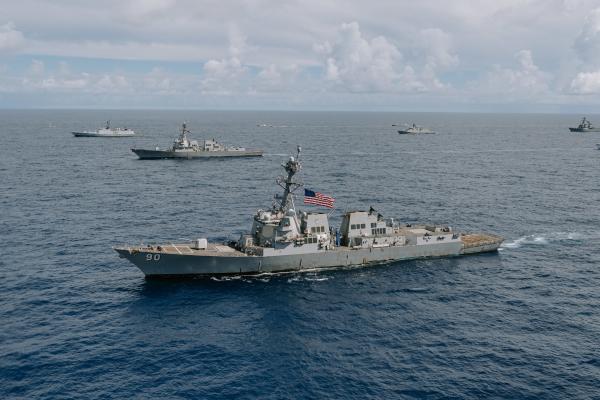
Join Hudson Senior Fellows Bryan Clark and Michael Roberts for a discussion with government and industry leaders about the challenges the US Navy and Coast Guard face amid modernization efforts and how new legislation and regulation can help restore America’s maritime superiority.

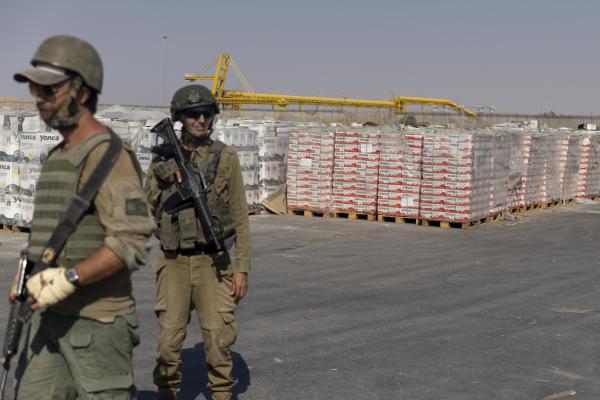
Join Hudson Institute Senior Fellow and Director for the Center for Peace and Security in the Middle East Michael Doran for a conversation with Reverend Johnnie Moore, president of the Congress of Christian Leaders and founder of the Gaza Humanitarian Foundation.

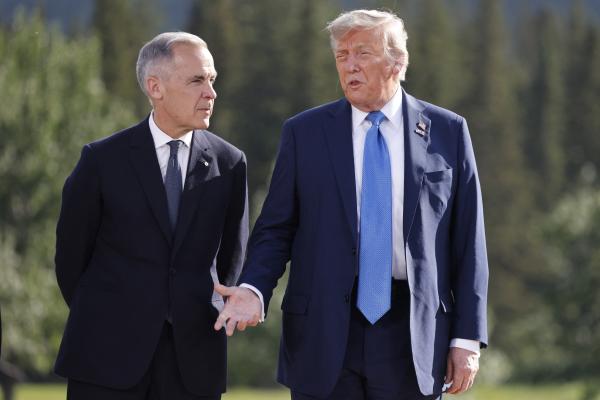
Join Hudson Senior Fellow Matt Boyse for a discussion with former Canadian Minister for Trade and Economic Development Ed Fast, and CNAPS Executive Director Jamie Tronnes, as they explore a new path forward for US-Canada relations and what other allies can learn from the process.




























